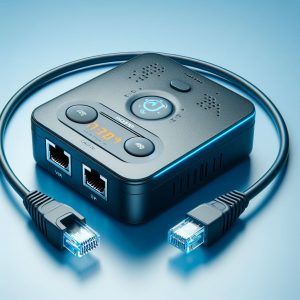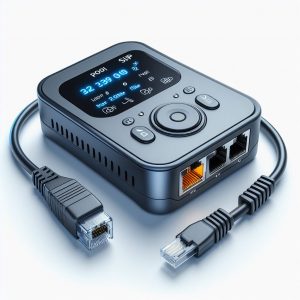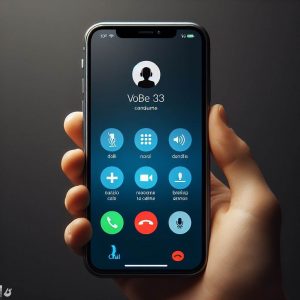Introduction
Asterisk is an open source software implementation of a private branch exchange (PBX) that routes calls like a business phone system. With its built-in support for Voice over IP (VoIP) protocols, Asterisk is a popular and flexible platform used to build VoIP solutions.
Brief overview of Asterisk
Created in 1999 by Mark Spencer, Asterisk is an open source project that provides the core PBX functionality needed for business communications. It is released under the GNU General Public License (GPL) and is free to use.
Asterisk supports an impressive range of telephony capabilities that enable integrating voice, video and other media communications via both VoIP and conventional telephony.
Importance of Asterisk in VoIP solutions
Asterisk plays a pivotal role in delivering VoIP based communications systems due to these key advantages:
- Free open source software makes it budget friendly.
- Modular architecture allows extensive customization and integration.
- Supports key VoIP protocols like SIP, H.323 and others.
- Interoperates with traditional telephony like analog lines and TDM.
- Available on Linux and other platforms with good community support.
These capabilities make Asterisk a versatile platform for deploying customized VoIP solutions from small businesses to large enterprises.
Asterisk: An Open Source PBX
Origins and development of Asterisk
Asterisk was created in 1999 by Mark Spencer as an open source alternative to proprietary PBX systems. It was initially targeted at Linux platforms.
Key milestones in Asterisk’s development include:
- 1999 – First version 1.0 released.
- 2001 – Launch of the Asterisk@Home project for hobbyist VoIP usage.
- 2004 – Asterisk becomes part of Digium and sees widespread enterprise adoption.
- 2006 – Support for IPv6 added to keep pace with evolving networks.
- 2015 – Release of Asterisk 13 adds features like built-in bridges and improved video support.
- 2020 – Asterisk 17 offers WebRTC support, better security and Python 3 migration.
Asterisk continues to be actively developed by the open source community and Digium.
Features and functionality of Asterisk
Some of the main features that make Asterisk a versatile PBX platform are:
- Call switching, management and call queueing.
- Support for multiple VoIP protocols like SIP, IAX2, MGCP, H.323 for unified communications.
- Integrated voicemail, IVR, auto attendant and conference calling.
- Call recording and monitoring capabilities.
- Media processing via codecs like G.711, G.722, G.729 for audio/video calls.
- Interfaces for integration with analog, digital and ISDN telephony.
- APIs for call control integrations using languages like PHP, Python, Java etc.
Interoperability with various VoIP protocols
A key advantage of Asterisk is its support for a range of VoIP protocols:
- SIP – Used for VoIP endpoints like IP phones and SIP trunks.
- IAX – Inter-Asterisk eXchange protocol used internally between Asterisk servers
- H.323 – Popular protocol used in VoIP and video conferencing.
- MGCP – Media Gateway Control Protocol manages media gateways and endpoints.
This multi-protocol support provides flexibility for unified communications.

Asterisk Components
Asterisk consists of several modular components that work together to enable telephony functions:
Asterisk channels: Telephony connections to the PBX
A channel handles a single active call leg and sources audio from the source to the PBX mixer. Some channel types are:
- SIP channels for VoIP endpoints registered to Asterisk via SIP.
- IAX2 channels for interconnecting Asterisk servers internally.
- H.323 channels for interfacing with H.323 hardware devices or gateways.
- Local channels for analog, digital and ISDN lines.
Asterisk H323 channels
The H.323 channel driver provides connectivity to H.323 compliant endpoints like:
- H.323 hardware phones e.g. Polycom, Yealink.
- H.323 VoIP gateways that connect to ISDN and analog lines.
- Video conferencing systems that use H.323.
It handles call signaling and media formats like G.711, G.722, G.729 used with H.323.
Asterisk IAX channels
IAX or Inter-Asterisk Exchange protocol is a lightweight VoIP protocol designed for efficient usage between Asterisk servers. key features are:
- Single UDP port for media and signaling.
- Low bandwidth overhead compared to SIP.
- NAT traversal support.
- Fast call setup.
IAX is well suited for trunk connections between remote Asterisk installations.
Asterisk SIP channels
The SIP channel driver interfaces with endpoints like:
- SIP phones, SIP ATAs supporting analog phones.
- SIP trunks between the Asterisk PBX and telephony providers.
- SIP video doorphones and survillance cameras.
It manages the SIP signaling for call management and provides codec support like G.711, G.722, G.729, Speex etc.
Asterisk Applications
Asterisk enables developing a variety of applications via its APIs and technologies like AGI:
Voice recognition system integration
Using Asterisk’s AGI interface, voice recognition platforms like Amazon Connect, Nuance Mix can be integrated to create IVR solutions, contact centers and more.
Interface with normal telephone lines and ISDN basic rate and primary rate interfaces
Using channel drivers, Asterisk can connect to:
- Analog and digital circuits like POTS, T1/E1/J1.
- ISDN protocols like PRI and BRI.
This allows supporting legacy telephony alongside VoIP.
Advanced services like video telephony and contact center applications
With Asterisk APIs, developers can create solutions like:
- Video conferencing servers supporting SIP and H.323 video endpoints.
- Contact center platforms with call monitoring, whisper, barge-in capabilities.
- Click to call applications using Asterisk’s fast AGI-based dialing.

Asterisk Interoperability
Compatibility with various VoIP hardware and software
Asterisk provides out-of-the-box compatibility with a wide range of endpoints:
- Major SIP phone brands like Polycom, Yealink, Cisco, Grandstream etc.
- SIP analog telephone adapters like Linksys PAP2T, ObiHai, Cisco SPA112 etc.
- SIP intercoms and video door stations from vendors like Commend, 2N, Axis Communications etc.
- Support for gateways that bridge ISDN, analog and digital circuits.
Support for most SIP telephones and other VoIP protocols
In addition to SIP phones, Asterisk supports:
- H.323 endpoints like Polycom and Yealink H.323 handsets.
- Proprietary protocols like Skype for Business.
- WebRTC for browser to phone calling.
Integration with traditional circuit-switching protocols like ISDN and SS7
Asterisk supports legacy protocols used widely in enterprise phone systems:
- ISDN PRI/BRI for connecting legacy PBX systems.
- SS7 for interconnecting phone networks via SIGTRAN.
- Multifrequency signaling used in North America and parts of Asia.
Asterisk Deployment
Benefits of using Asterisk for businesses
Businesses can realize significant benefits by deploying Asterisk:
- Cost savings compared to expensive proprietary PBXs.
- Avoid vendor lock-in due to open standards support.
- Flexibility to customize and integrate with other business apps.
- Scalability from small offices to large multi-site enterprises.
- Control over adding new features and upgrades.
Cost-effectiveness and flexibility for small businesses and large enterprises
Both small businesses and large enterprises find Asterisk attractive:
Small business
- Low startup costs by using free open source software.
- Lean custom solutions instead of bloated PBX features.
Large enterprises
- Drive down infrastructure costs at scale.
- Tightly integrate communications across business processes.
- Connect multi-site Asterisk servers via IAX trunking.
Wide range of add-on products for extended features and capabilities
A vibrant ecosystem of products extend Asterisk functionality:
- Endpoints like IP phones, gateways, SIP trunks.
- UC clients like Zulu and Bria for VoIP roaming.
- Modules for contact center, call recording etc.
- Management and monitoring dashboards.
- Commercial support subscriptions from Digium and others.

Asterisk Development
Open-source software, allowing for customization and integration
As open source software, Asterisk can be customized via:
- Adding modules and patches for new functionality.
- Integration with web apps using Asterisk Gateway Interface (AGI).
- Modifying dialplan configurations for unique call flows.
- Building new Asterisk channels for interfacing with hardware.
Running on various operating systems with technical knowledge
Asterisk runs on several operating systems:
- Linux distributions like RedHat, Debian, CentOS.
- BSD variants like FreeBSD.
- Windows when compiled natively or via WSL.
- Virtualized platforms like VMWare, VirtualBox, Hyper-V.
Technical expertise is needed for installation and management.
Community support and resources for developers
Active forums like /r/asterisk on Reddit and Asterisk Community forum provide peer support. Documentation covers installation, administration and configurations. Certification programs like CPAS provide structured learning. Overall, resources exist for developers to tap into the Asterisk community.
Conclusion
Summary of key points
In summary, Asterisk is an open source PBX that enables deploying customized VoIP solutions from SMBs to large enterprises. Its support for multiple protocols, ability to integrate with legacy systems and open source accessibility make Asterisk a highly capable platform for VoIP.
Future development and prospects of Asterisk in the VoIP industry
Asterisk will continue evolving with new versions adding features and improvements. Adoption is expected to keep rising as organizations look to open standards for avoiding vendor lock-in. With strong community support, interoperability and scalability, Asterisk has bright prospects to remain a leading open source force in the VoIP industry.
I. Introduction to T-Mobile VoIP
Definition of VoIP (Voice over Internet Protocol)
VoIP or Voice over Internet Protocol refers to communication technologies that allow making voice calls over an internet connection instead of traditional phone lines. VoIP converts analog voice signals into digital data packets that can be transmitted over the internet. At the receiving end, the packets are decoded back into analog signals.
VoIP allows providing voice services more efficiently using shared network infrastructure. Call quality can rival conventional landline phones with modern networks.
T-Mobile’s use of VoIP technology in its services
As one of the largest mobile carriers in the US, T-Mobile utilizes VoIP in various offerings to deliver voice services over data networks. This includes:
- T-Mobile LineLink service which relies on VoIP technology.
- Partnership with Ooma for expanding VoIP based home phone options.
- Expanding VoIP capabilities on T-Mobile’s cellular and home internet plans.
- Upgrading network infrastructure for delivering VoIP calls more efficiently.
VoIP is a strategic technology for T-Mobile as it transitions voice services to run over broadband and mobile data.

II. T-Mobile VoIP Services
Description of T-Mobile LineLink
T-Mobile LineLink is a home phone service offered by T-Mobile using VoIP technology:
Overview and features
LineLink aims to provide a low cost but full-featured home phone service on T-Mobile’s network using VoIP. It offers unlimited local and domestic long distance calling.
Key features include:
- WiFi calling capabilities – Make calls over WiFi when cellular coverage is weak.
- HD voice for improved clarity.
- Visual voicemail support.
- Calling features like call forwarding, waiting, conferencing and more.
Connection to the T-Mobile network with VoIP technology
LineLink works by connecting a physical adapter device to the customer’s broadband router via Ethernet. This Analog Telephone Adapter (ATA) links up traditional home phone devices to T-Mobile’s IP network.
The ATA converts analog voice signals from the regular phones to digital packets for transmission over the internet using VoIP. These packets are routed to T-Mobile’s servers which connect the call. VoIP enables delivering the home phone service efficiently over broadband.
Calling features and limitations
LineLink delivers modern calling capabilities backed by T-Mobile’s network:
- Unlimited nationwide calling without long distance charges.
- Basic features like caller ID, call forwarding, 911 access are included.
- International calling is available at extra cost per minute.
- Number porting is available to transfer an existing number to LineLink.
- There are some limitations compared to full cellular plans. For example, no roaming, limited 911 locating, etc.
Requirements for using LineLink
To use LineLink, users need:
- A compatible analog phone
- T-Mobile’s Analog Telephone Adapter device
- High speed home internet connection
- A T-Mobile LineLink plan subscription
With these elements, customers can use their regular home phones over T-Mobile’s VoIP network.
Partnership with Ooma
T-Mobile has partnered with Ooma, one of the leading VoIP network providers, to expand its VoIP services:
Highlighting the strength of the partnership
The Ooma partnership allows T-Mobile to tap into the capabilities of one of the most advanced VoIP networks to strengthen its offerings. Specifically:
- Ooma provides the underlying network for T-Mobile’s LineLink service.
- The partnership also allows T-Mobile customers preferred pricing on Ooma’s VoIP equipment like the Ooma Telo.
- T-Mobile customers can subscribe to Ooma home phone packages at reduced pricing.
This creates a win-win partnership where both companies can grow their VoIP customer base.
Expected growth from the reselling deal
By reselling Ooma’s services, T-Mobile can drive further growth in its home phone offerings without large infrastructure investments. Ooma benefits from accessing T-Mobile’s marketing resources and customer reach.
The success of LineLink and continued partnership shows the increasing strategic importance of VoIP services for T-Mobile’s growth. Expanding VoIP offerings is expected to appeal to cord-cutting households looking for flexible home phone options.
T-Mobile Home Internet and VoIP
T-Mobile’s emerging home internet service also intersects with VoIP capabilities:
User experiences with VoIP devices on T-Mobile home internet
Many customers pairing T-Mobile Home Internet with VoIP devices for home phone service report positive experiences. The home internet plans provide plenty of bandwidth for steady VoIP call quality.
Some users mention better call reliability compared to VoIP over cellular. However, individual experiences can vary based on local network conditions.
Issues and solutions related to using VoIP over T-Mobile home internet
Some users have reported issues like:
- Choppy call quality during peak usage or network congestion.
- Difficulty with 911 location accuracy.
- Limitations in using hardware like ATAs with the public IP addresses.
While T-Mobile is working to improve VoIP support, users have found workarounds like:
- Adding a VoIP optimized wireless router to prioritize voice traffic.
- Supplementing VoIP use with cell phones for 911 and reliability.
- Porting numbers to VoIP providers like Google Voice instead of T-Mobile VoIP.
As home internet plans evolve, VoIP call quality is expected to reach parity with conventional options. But currently it requires some technical diligence by customers.

III. Technical Aspects of T-Mobile VoIP
Technical requirements for using T-Mobile VoIP services
To use VoIP services reliably on T-Mobile’s network, some key technical requirements include:
- A broadband internet connection with sufficient bandwidth and low latency. For home use, typically need at least 10 Mbps download speeds.
- VoIP capable devices like IP phones, ATAs, or VoIP apps.
- For ATAs, an active T-Mobile SIM is required along with compatible unlocked devices.
- IP addresses should be public-facing rather than behind NAT to avoid issues.
- Port forwarding correctly configured on the home router for the VoIP device.
- WiFi connectivity in areas where cellular network is weak.
Meeting these requirements provides the foundation for good call quality on T-Mobile’s VoIP platform.
Whitelisting of IPv4 address blocks
T-Mobile provides documentation for whitelisting IP blocks to prioritize traffic from VoIP devices. This improves call quality and reliability for services like LineLink.
The IP blocks are updated regularly as T-Mobile enhances network infrastructure for VoIP. Admins should check the latest whitelist requirements and configure firewalls appropriately.
Setup and troubleshooting of T-Mobile VoIP devices
End user documentation is provided for setting up services like LineLink with the ATA adapters. This covers:
- Connecting adapter to home router and analog phone devices.
- Activating T-Mobile SIM card and associating with LineLink number.
- Configuring WiFi and testing connectivity.
- Troubleshooting steps if calls fail or quality is poor.
For advanced network troubleshooting, tools like ping, traceroute help verify connectivity between the user’s environment and T-Mobile’s VoIP endpoints.
Overall, T-Mobile aims to make the service plug-and-play but some technical diligence ensures optimal functioning.
IV. Regulatory and Compliance Aspects
FCC regulations and the transition from POTS to VoIP
The FCC regulates VoIP services to ensure standards like:
- 911 access and location accuracy.
- Disability access and video relay capabilities.
- Protecting consumer privacy and call records.
- Legal intercept capabilities and CALEA compliance.
As wireline POTS transitions to VoIP, providers like T-Mobile must update solutions to meet the same requirements such as E911.
T-Mobile’s compliance with VoIP-related regulations
T-Mobile keeps up with evolving VoIP regulations:
- It provides E911 access on VoIP services but warns limitations compared to 911 on cellular.
- It supports disability access like video relay services over VoIP.
- They issue transparency reports on information disclosure and legal requests.
Staying compliant allows T-Mobile to responsibly transition POTS lines to regulated VoIP services.
Emergency service and 911 access for T-Mobile VoIP users
T-Mobile provides 911 access on VoIP services but highlights that location accuracy may be limited compared to cell network 911:
- For LineLink ATA users, registered service address is used for 911 since devices are stationary.
- For mobile VoIP use over WiFi calling, phone GPS and cell tower location may not be accessible.
Users should be aware of potential E911 limitations depending on how T-Mobile VoIP services are being accessed.

V. Business Solutions and Collaboration
T-Mobile’s VoIP offerings for businesses
T-Mobile caters to business needs by enabling VoIP integrations on its cellular plans:
- Integrated business communications from Broadsoft, Mitel and other platforms.
- IP PBX systems can integrate with cellular for unified communications.
- WiFi calling and VoLTE support reliable VoIP on mobile devices.
- Dedicated support resources for enterprise accounts and network needs.
Cloud communication and collaboration tools provided by T-Mobile
Additionally, T-Mobile partners with third-party cloud business phone providers that utilize VoIP technology for advanced capabilities:
- Integrated phone, conferencing, contact center and other tools.
- Flexibility to use desktop or mobile apps along with desk phones.
- AI powered features like real-time translation, automated attendants etc.
VoIP integration enables T-Mobile to deliver complete network solutions for organizations.
VI. Conclusion
Summary of T-Mobile’s VoIP services and their implications
T-Mobile is clearly embracing VoIP technology to gradually transition its voice services away from legacy networks. Offerings like LineLink, Ooma partnership and improving cellular VoIP demonstrate this strategic direction.
For consumers, it aims to provide more flexible home phone options beyond traditional landlines. For businesses, VoIP integration enables cloud communications and mobility.
Future prospects and developments in T-Mobile’s VoIP offerings
T-Mobile is expected to expand its VoIP portfolio as it continues enhancing its IP network capabilities. More unified communication features will get integrated into cellular plans. Partnerships with communication app vendors could bring VoIP powered integration.
With 5G scaling up, VoIP over mobile data will become even more viable. T-Mobile is poised to lead mobile carriers in leveraging VoIP to disrupt traditional voice services. While technical challenges persist, the long-term outlook remains bright.
I. Introduction
A. Definition of VoIP Adapter
A VoIP (Voice over Internet Protocol) phone adapter, also known as an analog telephone adapter (ATA), is a device that allows you to use traditional analog phones, fax machines, and other analog devices on digital Voice over Internet Protocol (VoIP) phone networks. The adapter converts analog signals into digital data that can be transmitted over the internet, and vice versa.
B. Importance in bridging analog and digital networks
VoIP adapters play a crucial role in bridging legacy analog telephone systems with modern digital VoIP networks. As businesses transition their phone systems to VoIP for cost savings and advanced capabilities, VoIP adapters allow them to continue using existing analog phones, fax machines, modems, and other analog devices that rely on traditional telephone networks. The adapters seamlessly integrate these devices into the new digital systems. VoIP adapters also enable consumers to use their regular home phones with VoIP services provided by their cable company or third party providers. Overall, VoIP adapters facilitate the adoption of VoIP technology by enabling backwards compatibility.
II. What is a VoIP Adapter?
A. Functionality
1. Bridging analog and digital signals
The core functionality of a VoIP adapter is to bridge the gap between analog and digital voice communications. It provides the following signal conversions:
- Analog (voice, fax) to digital – The VoIP adapter takes the analog audio signals from traditional phones and converts them into digital packets that can be transmitted over the internet. This allows sending and receiving calls over VoIP networks.
- Digital to analog – In the other direction, the adapter converts the digital VoIP audio back into analog signals that can be output by conventional phones. This allows analog phones to receive VoIP calls.
2. Connecting analog devices to VoIP services
VoIP adapters allow analog telephones, fax machines, modems and other analog equipment to access and use VoIP phone services. This includes:
- Connecting regular home phones to residential VoIP services like those from cable providers
- Integrating office analog phones and fax machines with business VoIP phone systems
- Enabling analog devices to utilize VoIP features like call routing, voicemail to email, call recording and more.
B. Technical overview
1. Connection to local area network
VoIP adapters connect to the local area network via an ethernet port or WiFi. This allows them to access the VoIP phone system which is normally hosted on a private business network or by a residential VoIP provider. The adapter links analog devices to the same network.
2. Integration with analog phone systems
The VoIP adapter integrates with existing analog telephone systems using RJ-11 FXS (“foreign exchange station”) ports. Analog phones or other devices plug directly into the FXS ports on the adapter using standard telephone cables. Multiple ports allow connecting multiple analog devices. The adapter appears just like a regular phone line to the attached analog equipment.

III. How Does a VoIP Adapter Work?
A. Signal conversion process
1. Analog to digital and vice versa
VoIP adapters work by converting analog signals to digital packets, and vice versa:
- Analog to digital: The adapter takes the analog voice signal from a traditional phone handset and converts it into a digital signal using a codec (coder-decoder). This digitizes the voice so it can be assembled into IP packets and transmitted over the internet. Popular codecs used by VoIP adapters include G.711, G.729 and G.722.
- Digital to analog: In the reverse direction, the incoming digital VoIP data (packets) from the network are extracted by the adapter and decoded back into an analog voice signal using the codec. This analog signal can then be output to a regular phone handset to be heard by the recipient.
This bidirectional conversion between analog and digital domains is what allows the two technologies to interconnect and talk to each other.
B. Integration with VoIP systems
1. Call routing and queuing for efficiency
VoIP adapters seamlessly integrate with VoIP phone systems to enable efficient call routing and management:
- When an analog phone connected to the adapter makes a call, the adapter forwards the signaling and digitized voice data to the VoIP phone system.
- The VoIP system handles call routing, call switching, call forwarding, dial plans and other call management features.
- During high call volumes, calls may be queued and switched efficiently using the VoIP system before sending the voice signals back to the adapter for analog output.
- The adapter essentially acts as an analog end-point for the digital VoIP network while handling the analog to digital conversion.
This tight integration allows businesses to retain the flexibility and features of their VoIP phone systems while getting analog devices online.
IV. Types of VoIP Adapters
There are two main types of VoIP adapters used to connect analog devices to VoIP networks:
A. Analog Telephone Adapter (ATA)
An analog telephone adapter (ATA) is a device that acts as a gateway to connect one or more standard analog phones to a VoIP network. It is the most common and cost-effective type of VoIP adapter used by residential customers and small businesses.
Key features of an ATA include:
- RJ-11 FXS ports to connect analog phones using regular phone cables
- RJ-45 ethernet port to connect to a router or modem for VoIP network access
- Built-in codec to convert signals between analog and digital formats
- Dial tone simulation to make the VoIP system seem like a normal phone line
- Call features like call waiting, caller ID, call forwarding etc.
Popular ATAs include the Linksys PAP2, Obihai OBi200, Cisco SPA112, Grandstream HT802 etc. ATAs are sold by VoIP providers or purchased standalone. They aim to be simple plug-and-play devices for easy analog phone usage over VoIP.
B. SIP Adapter vs. VoIP Gateway
For larger businesses with PBX phone systems, the choice is between a SIP adapter or VoIP gateway to integrate analog devices:
1. Technical capabilities and cost-effectiveness
SIP Adapter
- Designed for use with SIP (Session Initiation Protocol) based VoIP PBX systems
- Acts as a SIP endpoint registering directly to the SIP PBX
- Handles SIP signaling and voice digitization
- Cost-effective solution for small to medium business needs
VoIP Gateway
- More advanced capabilities compared to a SIP adapter
- Can register multiple SIP endpoints from various analog devices
- Extra features like local voice switching without sending data to the IP PBX
- More expensive but can handle larger numbers of device integrations
Generally, SIP adapters are used by small businesses while large enterprises use VoIP gateways to integrate their legacy analog infrastructure. The right solution depends on the technical needs and budget.

V. Using VoIP Adapter with Wireless Network
A. Benefits of wireless connectivity
Using a VoIP adapter over WiFi and wireless networks provides benefits like:
- Flexibility – Phones can be used without stranded wires running through the building. Users can move around while on voice/video calls.
- Cost savings – No need for rewiring or installing ethernet cables to use VoIP adapters. WiFi is generally already available.
- Scalability – Its easy to add more analog phones by just plugging into available adapters. No need to run additional wires or cables.
B. Tips for seamless integration
1. Utilizing wireless bridges for stability
For best performance, plug the VoIP adapter into a wireless bridge connected to the WiFi router rather than connecting directly. Wireless bridges provide a stronger and more stable signal which is important for VoIP call quality.
2. Connecting IP phones for cost-effective calling
Combine analog adapters with a few VoIP wireless IP phones. IP phones allow making VoIP-to-VoIP calls within the network at no cost without needing the analog conversion. This reduces load on the limited adapters.

VI. Conclusion
A. Growing importance of VoIP adapters in residential and business settings
As Voice over IP technology becomes ubiquitous, VoIP adapters play a crucial role in facilitating the transition from legacy analog systems to digital VoIP networks. The adapters allow consumers and businesses to retain their analog phones, faxes and other gear while migrating phone systems to VoIP for enhanced capabilities. VoIP adapter use will continue growing both in homes and enterprises.
B. Future prospects and advancements in VoIP technology
VoIP adapter technology will evolve along with VoIP networks. Adapters will add support for newer protocols like WebRTC along with improved codecs for HD voice quality. Configurations will be increasingly automated using TR-069 and zero-touch provisioning. As VoIP services spread globally, more options will become available from leading vendors. With strong prospects ahead, the ordinary analog adapter will continue playing an extraordinary role in the digital revolution.
-
Introduction
Voice over Internet Protocol (VoIP) has revolutionized communication by allowing users to make phone calls over the internet instead of traditional telephone lines. For iPhone users, VoIP unlocks a host of useful features for both personal and professional needs. From inexpensive international calls to seamless integration with your iPhone’s native dialer app, VoIP empowers iPhone users with flexibility and functionality.
With the right VoIP app, iPhone users can benefit from HD sound quality on calls, video conferencing, screen sharing, instant messaging, call recording/logging, and other powerful communication tools. VoIP services integrate tightly with your iPhone contacts and call history, providing one cohesive experience. Many VoIP apps also allow you to use your iPhone number as your caller ID when making calls over Wi-Fi or cellular data.
For businesses, VoIP apps help teams collaborate through features like group messaging, file sharing, meetings, and more. Companies can maintain a professional image by displaying their business name and logo to recipients. VoIP solutions also enable advanced functionality like intelligent call routing, interactive voice response systems, and cloud phone systems connected to your office’s landline numbers.
Overall, with limitless global connectivity, crystal clear call quality, and robust features for productivity, VoIP apps unlock the potential for iPhone users to communicate better than ever before – both personally and professionally. The rest of this article will explore the top VoIP apps, best practices for calls, business solutions, CallKit integration, and more to help you harness the power of VoIP services on your iPhone.

Making VoIP Calls on iPhones
To start using VoIP services on your iPhone, there are a couple of requirements. First, you will need an app connected to a VoIP provider over Wi-Fi or mobile data. Popular apps include Skype, WhatsApp, Facebook Messenger, Google Voice, and more dedicated business VoIP platforms. Second, for optimal call quality, ensure you have a stable high-speed internet connection for smooth, uninterrupted service.
When ready to make a call, open your preferred VoIP app and dial just like you would on a voice call. Depending on the platform, you can call other users on the same service or phone numbers worldwide. If calling another number, input the full phone number with country code to connect. Enjoy crystal clear sound quality and reliability powered by VoIP technology.
In addition to the apps pre-installed on your iPhone, hundreds of third-party VoIP apps are available for download on the App Store. Popular options include Viber, MagicJack, Fongo, and Line2. These apps allow you to leverage VoIP calling into your existing iPhone calling experience and contacts. Some apps will even assign you a real phone number to use as your caller ID, with the ability to call any number directly from the app. This deep integration makes the process smooth and convenient.
Overall, making VoIP calls on your iPhone is simple with the range of available apps. Just connect to Wi-Fi or cellular data, install your preferred platform, enter a phone number, and enjoy superior call quality at little to no cost. The technology has revolutionized communication around the globe.
III. Best VoIP Apps for iPhone
With dozens of VoIP apps on the App Store, deciphering the best option for your needs can be challenging. To simplify your decision, here is a comparison of the top 10 VoIP apps for iPhone in 2024 based on features, reliability, sound quality, value, and more.
Ooma Office
Ooma Office tops our list as a robust cloud-based phone service for small businesses. It delivers excellent call quality via the iOS app. Features include a virtual multi-line phone system, intelligent call routing, voicemail transcriptions, ring groups, hold music, conference calling, and fax capabilities. At $19.95 per user/month, it provides enterprise-grade tools.
Vonage
For consumers and solopreneurs alike, Vonage stands out as the best overall VoIP app. It offers unlimited talk and text to the US, Canada, Mexico, and more on Wi-Fi. Vonage assigns you a real phone number and seamlessly integrates contacts and call history across devices. With video conferencing, instant messaging, and team messaging, it facilitates easy collaboration. Top-notch customer service and affordable international rates make Vonage well-rounded and versatile for personal use.
Dialpad
Dialpad shines for its artificial intelligence capabilities. The app features real-time speech recognition to transcribe voicemails into text automatically. You can also search call and SMS content for keywords to jog your memory on past conversations. With Slack integration, UberConference video meetings, and intelligent contact profiles, Dialpad leverages AI to streamline team collaboration. At $15 per user/month, it removes friction from communication.
Skype
A pioneer in the VoIP space, Skype continues offering reliable, low-cost global calling pay-as-you-go rates from your iPhone. Features include instant messaging, screen sharing, call recording, group video chats for up to 50 people, and Outlook integration. While more consumer-focused, Skype remains a popular app to connect internationally across platforms.
Google Voice
Google Voice makes it possible to consolidate messaging across devices into one intuitive iOS app. Features include free SMS, MMS picture messaging, voicemail transcripts, call blocking, conference calling, call history syncing, international rates from 1 cent per minute, and intelligent spam call protection. Seamlessly transition calls between your iPhone, iPad connected devices.

Line2
Specifically designed for business owners, Line2 provides a second business line on your iPhone to keep work calls separate from personal ones. Easily toggle between your two numbers on the fly or on a schedule. Features include SMS/MMS messaging, conference calls, call forwarding, voicemail transcription, fax services, and integrations with business software platforms. Plans start at $9.99 per month after a 7-day free trial.
Fongo
For affordable home phone replacement, Fongo allows you to port your existing number to its VoIP service. You can make unlimited nationwide calls and texts to US and Canadian numbers. Features include free phone numbers, voicemail-to-text, call forwarding, conference calling, call blocking, and SMS capabilities. At $9.99/month after a generous free trial, Fongo makes ditching your landline easy and wallet-friendly.
MagicJack
With deep integration into your iPhone’s native Phone app, MagicJack essentially operates as an additional line. It provides unlimited local and long distance calling. Features include free phone numbers, voicemail, call waiting, call forwarding, 411 directory access, conference calling, and video messages for $2.99 per month. MagicJack also sells pre-paid international minutes starting at $10 for 240 minutes.
SnapDial
SnapDial focuses purely on delivering lowest cost international calling starting at 1 cent per minute. Make affordable calls to landline numbers in over 200 countries. Features include in-app calling minutes top-up, SMS messaging, call history, iPhone contacts syncing, and free number transfer into the app. SnapDial provides budget-friendly global connectivity.
Talkatone
Lastly, for a completely free option, Talkatone provides basic VoIP functionality with no hidden fees. Features include free calls within the US, call forwarding, conference calling, SMS messaging, voicemail boxes, and free number assignment. As an ad-supported app, Talkatone does show promotions but is fully functional for simple calling needs.
In summary, when choosing a VoIP app for iPhone, weigh your priorities like business solutions vs personal use, advanced functions like video conferences, number porting capabilities, international call rates, and overall value for money based on functionality. Any app above will serve you well, with Vonage striking the best balance as an affordable and fully-featured option for consumers. Enjoy exploring VoIP capabilities on your iPhone!
VoIP Solutions for Business Communication
For business owners, VoIP apps unlock powerful potential for empowering team collaboration on iPhones. Instead of traditional PBX landline systems, VoIP facilitates mobile-first cloud phone solutions accessed through convenient iOS apps. Features like intelligent call routing, multi-line support, real-time call analytics, voicemail transcriptions, SMS capabilities, instant messaging, video meetings, and more streamline communication.
VoIP apps also nurture stronger client relationships by providing call forwarding, interactive voice responses, detailed call logs, and screen recording tests for customer support. For effective internal communication, team messaging keeps all discussions centralized for reference. File sharing eliminates version chaos from long email chains. Video conferences enable productive meetings on the go versus being deskbound.
With VoIP business apps, iPhone users maintain a professional image with branded caller IDs featuring your logo, tagline, employee names, and contact information for recipients. Keep work calls separate from personal lines or leverage number masking to protect privacy. For organizations without receptionists, intelligent call routing based on menus or office hours facilitates self-service for customers to the right department.
For cost management, VoIP solutions provide reliable unlimited national calling with free internal communication between employees. International rates are significantly lower than traditional providers, saving your business money abroad. Call analytics also control expenses by reporting metrics like peak call times to inform optimal staffing needs versus wasted energy during slow periods.
Overall, by leveraging VoIP apps tailored for business, companies streamline teamwork, nurture customer relationships, maintain professionalism, route calls intelligently, drive profits with cost savings, and equip organizations with mobility. For iPhone users, VoIP facilitates easier collaboration sans office desk phones, aligning with flexible remote work arrangements. Sample platforms include Ooma Office, Dialpad, Line2, RingCentral, Aircall, eVoice, and Grasshopper. Embrace the potential to communicate faster and smarter using VoIP solutions for business.

Using CallKit for VoIP Calls
For VoIP apps providing core calling capabilities, Apple provides the CallKit framework for deeper iPhone integration. By tapping into CallKit functionality in iOS, VoIP apps can provide native dialer experiences, recent call display in the Phone app, contact matching, handover between Wi-Fi and cellular, spatial audio for calls, and more.
Essentially, CallKit allows your custom VoIP app experience to blend seamlessly with default iPhone calling habits. Instead of separate apps and call histories, CallKit enables VoIP platforms to fully customize the native Phone app workflow itself.
For example, when receiving a VoIP call using CallKit, it will look and behave exactly like a regular iPhone call with integrated notification prompts, sounds and haptics. Users don’t need to memorize new behaviors. CallKit also facilitates number masking easily so your main iPhone number can display as the caller ID for VoIP calls instead of random app IDs.
During an active VoIP call leveraging CallKit, you can fluidly transition between Wi-Fi and mobile data networks if moving locations or if internet quality drops. The receiver simply continues an uninterrupted call experience as the transport layer switches behind the scenes. CallKit also enables proper TTY mode and reporting for call statistics like routed calls versus unanswered ones.
Overall for developers, building VoIP apps, CallKit integration ensures the default iPhone calling experience shines through. This facilitates mass user adoption for platforms looking to scale who don’t expect users to memorize complicated new behaviors. CallKit ultimately exists to simplify and unify. By tapping into its tools, VoIP apps can focus more on innovative functionalities around efficient communication versus wrestling with core call management re-invention.
Conclusion
In the modern mobile era, VoIP apps for iPhone deliver meaningful connectivity, convenience, and collaboration features beyond possible on analog telephone networks. From superior call quality powered by broadband internet instead of choppy plain old telephone service (POTS) lines to integrated business communication tools facilitating teamwork, VoIP unlocks potential.
With the dozens of solutions available on the App Store, iPhone users should weigh priorities like international rates, number portability, advanced functionalities around video meetings or AI analytics, brand customization for business, and deep native integration using CallKit frameworks. Top providers like Vonage, Dialpad, Line2, and Ooma Office cover the full range of consumer and business communication needs with reliability and value built-in.
Now is the time to experience VoIP capabilities firsthand to appreciate the crystal clear audio, helpful productivity features like voicemail transcriptions, and affordability to boot. Whether an individual iPhone user wanting to save money on personal calls abroad or business owners striving to equip growing remote teams, VoIP solutions exist to meet specialized needs while unifying and smoothing iPhone calling experiences. Thanks to CallKit integration, receivers enjoy the native dialer and smart contacts they already know and love with all the upsides of VoIP layered in.
Overall, as communication continues trending mobile, VoIP apps for iPhone present exciting opportunities to save money, build meaningful connectivity, and power smarter collaboration all through convenient iOS apps. The technology has fully arrived at a mature stage ready to deliver reliability and daily usefulness both personally and professionally. Give VoIP on your iPhone a test drive – you will open capabilities guaranteed to impress as the future of telephony.
I. Introduction
Definition of VoIP Caller
A VoIP caller app allows users to make and receive voice calls over the internet using VoIP (Voice over Internet Protocol) technology instead of traditional analog telephone systems. VoIP converts analog audio into digital data packets that are transmitted over the internet to the call recipient.
Brief Explanation of How It Works
VoIP caller apps work by using your phone’s internet data connection or WiFi to route calls. By going through the internet rather than cell carrier networks or landlines, the audio can be converted into IP data packets to allow enhanced calling functionality and features. VoIP caller apps offer tremendous flexibility since you aren’t tied to a specific physical location or device for connectivity.
II. What is a VoIP Caller?
Using the Internet for Calls Instead of a Landline or Cell Carrier
The essential advantage of a VoIP caller app is utilizing your phone’s broadband internet or WiFi connection for calls rather than relying solely on cell carrier connectivity. This brings enhanced flexibility, mobility and savings compared to being physically tethered to a landline or dependent on cell minutes.
Some key perks of using internet calling include:
- Make and receive calls anywhere with internet access, not just where you have cell signal
- Avoid expensive international calling fees
- Enhanced call management features and voicemail options
- Affordable pricing structures and subscription models
- Higher audio fidelity on modern internet connections
Benefits for Businesses and Individuals
Both businesses and individual consumers can realize tremendous benefits from using a VoIP caller app, including:
For businesses
- Significant cost savings on calls, especially internationally
- Flexible work arrangements for remote teams
- Scalability when adding new employees
- Integration with CRM and other systems
- More professional appearance with custom business numbers
For individuals
- Affordable home phone replacement saving money
- Improved connectivity when traveling abroad
- Keep the same number when moving locations
- Advanced features like voicemail transcription
- Avoiding expensive cell carrier per-minute charges
Examples of VoIP Calling Apps
Some popular VoIP calling apps include:
- Skype
- WhatsApp
- Google Voice
- Vonage
- FaceTime Audio
- Signal
- Hangouts Dialer
- Viber
- Microsoft Teams
These apps allow calls via WiFi or data plans, opening substantial flexibility compared to relying solely on cell carrier connectivity and availability.

III. How VoIP Calling Works
Explanation of Voice over Internet Protocol (VoIP) Technology
The magic behind VoIP caller apps is Voice over Internet Protocol technology. VoIP converts analog voice signals (phone calls) into digital data packets that can be transmitted easily over the internet rather than traditional copper phone lines (PSTN).
VoIP systems have an encoder that changes the analog audio input into compressed digital packets that travel over the internet. A decoder on the recipient device decompresses the packets back into audio that both parties can understand.
This encoding and decoding process, paired with broadband internet and WiFi, enables the advanced flexibility of VoIP calling technology.
Overview of the Technical Process
Here is a simple step-by-step overview of placing a VoIP internet call:
- The caller opens the VoIP app on their smartphone, computer etc.
- The VoIP app connects to the internet via WiFi or mobile data.
- The caller enters the recipient’s username or assigned number.
- The app encodes the caller’s analog voice into digital packets.
- Packets get routed via the internet to the recipient’s device.
- Recipient app decodes packets back into analog audio.
- Call recipient hears the caller speaking to them through their device mic and speaker.
Comparison with Traditional Calling Methods
VoIP calling brings some key technical advantages compared to traditional telephony:
VoIP Calling
- Packets routed digitally over the internet
- Convert audio signals into compressed data
- Works anywhere with internet access
- Enhanced features like video calling
Traditional Calling
- Dedicated connection via copper wires
- No conversion of analog signals
- Physically tethered to telephone line
- Limited standard features
Leveraging digital connections opens substantial feature improvements and flexibility beyond traditional analog phone systems.
IV. VoIP Caller Apps
Features and Functionalities
VoIP caller apps contain a robust array of calling features, far outpacing standard cell phone calling. Common functionalities include:
- Domestic and international calling
- Call forwarding
- Call waiting
- 3-way calling
- Voicemail to email
- Call routing
- Auto attendant
- Call recording
- Video calls
- Screen sharing
- Instant messaging
- Presence indicators
- CRM integrations
These features enhance productivity and allow users much more control over their calling experience using VoIP internet telephony compared to conventional voice networks.
Examples of Popular VoIP Caller Apps
Some top examples include:
Skype
- Video calls for up to 24 participants
- Cheap international calls from mobiles and landlines
- Call forwarding and recording
- Voicemail and SMS messaging
- Mobile and desktop apps
WhatsApp
- Free international calls with other WhatsApp Users
- Group video calls up to 8 participants
- Voice messages and call history log
- Encrypted messaging and calling
- Mobile-first design
RingCentral
- Unlimited calling to US, Canada, and even some international destinations
- Custom business phone numbers
- Integrates with popular business apps
- Advanced call routing flow configuration
- Broad platform support
Considerations for Choosing a VoIP Caller App
Here are key factors to weigh when selecting a VoIP caller app:
- Cost and pricing model
- Number of participants supported on audio/video calls
- Platforms supported like desktop, iOS, Android etc.
- Voicemail and auto attendant capabilities
- Audio/video quality and call reliability
- Integration with existing business systems
- Reviews and ratings from current users
Consider your budget, business systems, team sizes and application platform preferences when selecting the best VoIP app for your needs from the myriad options on the market.

V. Benefits of VoIP Calling
Cost-Effectiveness
VoIP presents substantial direct cost savings over traditional phone services:
- No expensive PBX hardware purchases
- Slash monthly calling plan costs up to 50% or more
- Low per-minute international calling rates
- Affordable host of advanced features now bundled in
Plus, indirect team productivity enhancements and travel savings accumulate from enabling seamless remote work with exceptional call quality.
Flexibility and Scalability
Rather than managing phone lines and infrastructure, VoIP systems rely on flexible, easy-to-scale cloud platforms. Adding and supporting more lines as teams expand becomes straightforward thanks to intuitive online dashboards. Teams can also collaborate from anywhere with internet using desktop and mobile apps.
Integration with Other Business Tools
Leading VoIP solutions also integrate directly into popular CRM, help desk, project management and other systems central to daily operations. This creates powerful synergies and efficiency by converging separate platforms into interconnected ecosystems for each user. Calling capabilities then functions smoothly alongside all other essential software.
VI. Considerations for Businesses
Impact on Customer Support
With powerful call routing and management standard, VoIP can significantly enhance customer support capabilities:
- Automatically direct callers to appropriate agents
- Identify priority callers via features like custom call rules and VIP settings
- Gain insights into support metrics like average call duration per inquiry type
- Boost agent productivity with integrated knowledge bases and screen pops
This drives immense value through improving first-call resolution rates and overall customer satisfaction over the lifecycle.
Use Cases for Sales Teams
VoIP also assists sales teams through:
- Allowing separate business numbers for specific campaigns, regions etc.
- Identifying callers to customize engagement priorities
- Recording calls for future transcribing and analysis
- Enabling call popping directly into CRM system profiles
- Keeping remote sales teams connected through affordable international calling
The above use cases illustrate how VoIP apps generate higher sales productivity in addition to enhancing general business coordination.
Pros and Cons of VoIP Calling for Businesses
Pros
- Cost savings from cheaper calling
- Powerful advanced features
- Flexibility for remote teams
- Scales easily by adding new lines
- Integrations with business apps
- More professionalism
Cons
- Audio quality depends on internet connectivity
- Possible learning curve to utilize full feature set
- Limitations for offline work environments
- Emergency call functionality restrictions
Carefully evaluating the pros and cons against your unique environment allows maximizing benefits from transitioning business communication systems to modern VoIP caller app solutions.

VII. VoIP Caller App Overview: AT&T Office@Hand
Overview
AT&T Office@Hand represents an industry-leading VoIP platform meeting the demanding communication needs of today’s enterprises. Tight integration between voice, mobility and popular business apps drives productivity.
Features and Capabilities
Key features include:
Calling
- Cloud PBX business phone system
- Unlimited local & domestic long distance
- International prepaid calling options
- Auto attendants, call routing & screening
- Call analytics dashboard
Mobility
- Native iOS & Android apps
- Seamlessly transition calls between devices
- Extend office numbers to outside lines
- Limit private data usage
Messaging
- Video conferencing with screen sharing
- File sharing capabilities
- Secure group chat
- Third-party app integrations
Management
- Drag-and-drop call management console
- Grant tiered access to admins
- Robust conference call hosting controls
- Queue dashboards & real-time monitoring
How It Can Benefit Businesses and Individuals
Individuals
- Affordable home office setup
- Consistent business number across devices
- No more playing phone tag
Enterprises
- Improve team mobility productivity
- Intuitive conference and call management
- Gain cloud advantages without losing voice quality
- Tight integration with Office365 and leading CRM solutions
- Promote collaboration through messaging and meeting capabilities
office@hand strikes an ideal balance empowering employees while providing administrators oversight for traction.
VIII. Conclusion
Recap of the Advantages of VoIP Calling
In summary, key advantages of transitioning communications to VoIP caller apps include:
- Substantially lower costs
- Increased productivity
- Unified platforms
- Enhanced mobility
- Streamlined scalability
Encouragement to Explore VoIP Caller Apps for Personal and Business Use
Even for the casual user, exploring capable and affordable VoIP caller apps can bring savings and improved experiences over reliance solely on cell provider connections and plans. More advanced power users gain advantages like seamless device transitions and CRM integrations.
I. Introduction
Definition of VoIP Caller
A VoIP caller app allows users to make and receive voice calls over the internet using VoIP (Voice over Internet Protocol) technology instead of traditional analog telephone systems. VoIP converts analog audio into digital data packets that are transmitted over the internet to the call recipient.
Brief Explanation of How It Works
VoIP caller apps work by using your phone’s internet data connection or WiFi to route calls. By going through the internet rather than cell carrier networks or landlines, the audio can be converted into IP data packets to allow enhanced calling functionality and features. VoIP caller apps offer tremendous flexibility since you aren’t tied to a specific physical location or device for connectivity.

II. What is a VoIP Caller?
Using the Internet for Calls Instead of a Landline or Cell Carrier
The essential advantage of a VoIP caller app is utilizing your phone’s broadband internet or WiFi connection for calls rather than relying solely on cell carrier connectivity. This brings enhanced flexibility, mobility and savings compared to being physically tethered to a landline or dependent on cell minutes.
Some key perks of using internet calling include:
- Make and receive calls anywhere with internet access, not just where you have cell signal
- Avoid expensive international calling fees
- Enhanced call management features and voicemail options
- Affordable pricing structures and subscription models
- Higher audio fidelity on modern internet connections
Benefits for Businesses and Individuals
Both businesses and individual consumers can realize tremendous benefits from using a VoIP caller app, including:
For businesses
- Significant cost savings on calls, especially internationally
- Flexible work arrangements for remote teams
- Scalability when adding new employees
- Integration with CRM and other systems
- More professional appearance with custom business numbers
For individuals
- Affordable home phone replacement saving money
- Improved connectivity when traveling abroad
- Keep the same number when moving locations
- Advanced features like voicemail transcription
- Avoiding expensive cell carrier per-minute charges
Examples of VoIP Calling Apps
Some popular VoIP calling apps include:
- Skype
- WhatsApp
- Google Voice
- Vonage
- FaceTime Audio
- Signal
- Hangouts Dialer
- Viber
- Microsoft Teams
These apps allow calls via WiFi or data plans, opening substantial flexibility compared to relying solely on cell carrier connectivity and availability.

III. How VoIP Calling Works
Explanation of Voice over Internet Protocol (VoIP) Technology
The magic behind VoIP caller apps is Voice over Internet Protocol technology. VoIP converts analog voice signals (phone calls) into digital data packets that can be transmitted easily over the internet rather than traditional copper phone lines (PSTN).
VoIP systems have an encoder that changes the analog audio input into compressed digital packets that travel over the internet. A decoder on the recipient device decompresses the packets back into audio that both parties can understand.
This encoding and decoding process, paired with broadband internet and WiFi, enables the advanced flexibility of VoIP calling technology.
Overview of the Technical Process
Here is a simple step-by-step overview of placing a VoIP internet call:
- The caller opens the VoIP app on their smartphone, computer etc.
- The VoIP app connects to the internet via WiFi or mobile data.
- The caller enters the recipient’s username or assigned number.
- The app encodes the caller’s analog voice into digital packets.
- Packets get routed via the internet to the recipient’s device.
- Recipient app decodes packets back into analog audio.
- Call recipient hears the caller speaking to them through their device mic and speaker.
Comparison with Traditional Calling Methods
VoIP calling brings some key technical advantages compared to traditional telephony:
VoIP Calling
- Packets routed digitally over the internet
- Convert audio signals into compressed data
- Works anywhere with internet access
- Enhanced features like video calling
Traditional Calling
- Dedicated connection via copper wires
- No conversion of analog signals
- Physically tethered to telephone line
- Limited standard features
Leveraging digital connections opens substantial feature improvements and flexibility beyond traditional analog phone systems.
IV. VoIP Caller Apps
Features and Functionalities
VoIP caller apps contain a robust array of calling features, far outpacing standard cell phone calling. Common functionalities include:
- Domestic and international calling
- Call forwarding
- Call waiting
- 3-way calling
- Voicemail to email
- Call routing
- Auto attendant
- Call recording
- Video calls
- Screen sharing
- Instant messaging
- Presence indicators
- CRM integrations
These features enhance productivity and allow users much more control over their calling experience using VoIP internet telephony compared to conventional voice networks.
Examples of Popular VoIP Caller Apps
Some top examples include:
Skype
- Video calls for up to 24 participants
- Cheap international calls from mobiles and landlines
- Call forwarding and recording
- Voicemail and SMS messaging
- Mobile and desktop apps
WhatsApp
- Free international calls with other WhatsApp Users
- Group video calls up to 8 participants
- Voice messages and call history log
- Encrypted messaging and calling
- Mobile-first design
RingCentral
- Unlimited calling to US, Canada, and even some international destinations
- Custom business phone numbers
- Integrates with popular business apps
- Advanced call routing flow configuration
- Broad platform support
Considerations for Choosing a VoIP Caller App
Here are key factors to weigh when selecting a VoIP caller app:
- Cost and pricing model
- Number of participants supported on audio/video calls
- Platforms supported like desktop, iOS, Android etc.
- Voicemail and auto attendant capabilities
- Audio/video quality and call reliability
- Integration with existing business systems
- Reviews and ratings from current users
Consider your budget, business systems, team sizes and application platform preferences when selecting the best VoIP app for your needs from the myriad options on the market.

V. Benefits of VoIP Calling
Cost-Effectiveness
VoIP presents substantial direct cost savings over traditional phone services:
- No expensive PBX hardware purchases
- Slash monthly calling plan costs up to 50% or more
- Low per-minute international calling rates
- Affordable host of advanced features now bundled in
Plus, indirect team productivity enhancements and travel savings accumulate from enabling seamless remote work with exceptional call quality.
Flexibility and Scalability
Rather than managing phone lines and infrastructure, VoIP systems rely on flexible, easy-to-scale cloud platforms. Adding and supporting more lines as teams expand becomes straightforward thanks to intuitive online dashboards. Teams can also collaborate from anywhere with internet using desktop and mobile apps.
Integration with Other Business Tools
Leading VoIP solutions also integrate directly into popular CRM, help desk, project management and other systems central to daily operations. This creates powerful synergies and efficiency by converging separate platforms into interconnected ecosystems for each user. Calling capabilities then functions smoothly alongside all other essential software.
VI. Considerations for Businesses
Impact on Customer Support
With powerful call routing and management standard, VoIP can significantly enhance customer support capabilities:
- Automatically direct callers to appropriate agents
- Identify priority callers via features like custom call rules and VIP settings
- Gain insights into support metrics like average call duration per inquiry type
- Boost agent productivity with integrated knowledge bases and screen pops
This drives immense value through improving first-call resolution rates and overall customer satisfaction over the lifecycle.
Use Cases for Sales Teams
VoIP also assists sales teams through:
- Allowing separate business numbers for specific campaigns, regions etc.
- Identifying callers to customize engagement priorities
- Recording calls for future transcribing and analysis
- Enabling call popping directly into CRM system profiles
- Keeping remote sales teams connected through affordable international calling
The above use cases illustrate how VoIP apps generate higher sales productivity in addition to enhancing general business coordination.
Pros and Cons of VoIP Calling for Businesses
Pros
- Cost savings from cheaper calling
- Powerful advanced features
- Flexibility for remote teams
- Scales easily by adding new lines
- Integrations with business apps
- More professionalism
Cons
- Audio quality depends on internet connectivity
- Possible learning curve to utilize full feature set
- Limitations for offline work environments
- Emergency call functionality restrictions
Carefully evaluating the pros and cons against your unique environment allows maximizing benefits from transitioning business communication systems to modern VoIP caller app solutions.
VII. VoIP Caller App Overview: AT&T Office@Hand
Overview
AT&T Office@Hand represents an industry-leading VoIP platform meeting the demanding communication needs of today’s enterprises. Tight integration between voice, mobility and popular business apps drives productivity.
Features and Capabilities
Key features include:
Calling
- Cloud PBX business phone system
- Unlimited local & domestic long distance
- International prepaid calling options
- Auto attendants, call routing & screening
- Call analytics dashboard
Mobility
- Native iOS & Android apps
- Seamlessly transition calls between devices
- Extend office numbers to outside lines
- Limit private data usage
Messaging
- Video conferencing with screen sharing
- File sharing capabilities
- Secure group chat
- Third-party app integrations
Management
- Drag-and-drop call management console
- Grant tiered access to admins
- Robust conference call hosting controls
- Queue dashboards & real-time monitoring
How It Can Benefit Businesses and Individuals
Individuals
- Affordable home office setup
- Consistent business number across devices
- No more playing phone tag
Enterprises
- Improve team mobility productivity
- Intuitive conference and call management
- Gain cloud advantages without losing voice quality
- Tight integration with Office365 and leading CRM solutions
- Promote collaboration through messaging and meeting capabilities
office@hand strikes an ideal balance empowering employees while providing administrators oversight for traction.
VIII. Conclusion
Recap of the Advantages of VoIP Calling
In summary, key advantages of transitioning communications to VoIP caller apps include:
- Substantially lower costs
- Increased productivity
- Unified platforms
- Enhanced mobility
- Streamlined scalability
Encouragement to Explore VoIP Caller Apps for Personal and Business Use
Even for the casual user, exploring capable and affordable VoIP caller apps can bring savings and improved experiences over reliance solely on cell provider connections and plans. More advanced power users gain advantages like seamless device transitions and CRM integrations.
Introduction
Voice over Internet Protocol (VoIP) refers to making and receiving voice calls over the internet, rather than traditional analog telephone systems. It converts voice signals into data packets sent over the internet and converts received data packets back into voice on the other end. With high-speed mobile internet now abundantly available globally, using VoIP on smartphones like Android devices has become extremely popular.
Definition of VoIP
Simply put, VoIP allows transmitting phone calls over a broadband internet connection instead of traditional phone lines from a landline or mobile carrier voice services. It works by converting analog voice signals into digital data packets able to be transmitted over the internet and reassembled at the destination.
Special VoIP apps on devices like Android smartphones and tablets enable placing calls straight to other supported devices or bridges connections to interact with conventional PSTN phone numbers around the world at much lower costs. Android in particular represents an ideal platform for utilizing VoIP capabilities given its worldwide ubiquity across consumer and business users along with open standards support.
Advantages of Using VoIP on Android
Some key benefits Android users realize harnessing VoIP solutions include:
- Place phone calls over WiFi or mobile data rather than cell voice minutes
- Make international or long distance calls for free or at huge discounts
- Supports BYOD flexibility requirements
- Enables additional second business line capabilities
- Unlocks richer communication feature sets than traditional voice services
- Circumvents cellular carrier signal issues by routing over internet pipelines
- Allows much easier scalability supporting usage spikes ortemporary teams

Creating an Android VoIP Client
To make an Android device interact as a business or personal telephony endpoint over broadband internet instead of cellular voice, users must configure special VoIP client apps which speak the right protocols to interface with hosted VoIP platforms or other endpoints.
The open Session Initiation Protocol (SIP) powers setting up most real-time communication sessions over IP networks. Developers leverage SIP tools and standards to build Android apps bridging internet-based voice connections.
Explanation of SIP (Session Initiation Protocol)
SIP represents a signaling communication protocol widely used for controlling multimedia sessions including voice, video and messaging exchanges in real time between systems across the internet. It handles establishing session connections, determining capabilities supported on both ends and tearing down calls after completing.
VoIP apps use SIP to complete actions like dialing numbers or user addresses, triggering audio or video streams and bringing calls to an end. Its widespread support across VoIP solutions makes SIP the ideal signaling protocol enabling seamless interoperability for real-time media communications over IP, especially dominating modern cloud phone platforms.
Leading Android SIP client apps reference essential connection point details from hosted VoIP provider accounts to securely access services. Once authenticated and registered, Android apps leverage SIP to place and receive calls or bridge connections to outside numbers through associated VoIP platform call routing and PSTN gateways globally.
Steps to Set Up a SIP Client on an Android Phone
Configuring a SIP client app to activate VoIP calling capabilities involves installing a compatible app and entering a few key details from associated service provider accounts:
- Install SIP Client App – Many free, popular options exist like Groundwire, Acrobits Softphone, Zoiper or Linphone supporting core SIP features.
- Sign Up for VoIP Service Account – Create a basic VoIP service account with a provider like Nextiva, RingCentral, Ooma etc. to obtain necessary SIP registration credentials.
- Configure SIP Client Settings – Inside the app enter details like service URL or IP addresses, account user name, authentication passwords/pins and telephone number assigned.
- Set Outbound Call Routing – Specify whether to route calls over VoIP or cell networks for cost efficiency.
Once registered, Android devices can place and receive VoIP calls to other SIP devices or external numbers through the servicing operator’s bridges along with accessing supplemental voice capabilities.
List of Recommended Android SIP Clients
My top Android apps supporting core SIP protocol integration with VoIP services include:
- Acrobits Softphone – Robust SIP features plus team messaging abilities
- Groundwire – Intuitive interface and configuration for basic SIP calling
- Linphone – Open source Android VoIP client with extensive codec support
- Zoiper – User-friendly interface and connectivity diagnosis tools
- SIPDroid – Highly customizable SIP client for Android
- MizuDroid – Lightweight SIP softphone app
Review their capabilities and SIP support breadth alongside ratings when selecting among plentiful Android SIP client options available.
Making VoIP Calls with Android Phones
Once a compatible SIP client app completes registration configuration with a chosen VoIP operator, users enjoy native-like calling abilities over broadband internet on Android devices rather than consuming cellular voice minutes. Calls connect between other SIP registered endpoints or bridge to external destinations.
Process of Making VoIP Calls Using a SIP Client
- Open SIP Client App – Launch the registered softphone app to access dialpad and contact directories
- Dial Contact – Call contacts registered on the SIP VoIP platform directly like another business user or hunt group queue.
- Dial External Numbers – Input full external telephone numbers to connect calls via outbound PSTN bridges to landlines or mobile numbers worldwide.
- Receive Incoming Calls – When contacts dial users’ assigned personal VoIP numbers, SIP apps trigger incoming call notifications to connect calls.
Integration of Android Phone into a VoIP System
Once Android devices run a configured SIP client, they essentially act like fully integrated handsets on an enterprise or SMB VoIP phone system able to leverage call routing rules, hunt groups, IVRs, call parking and other advanced features supported.
Visibility into analytics like call logs/recordings and real-time monitoring also help administrators track usage and performance like any endpoint. Intuitive control menus embedded inside SIP apps provide users all the same mid-call capabilities like transfers, intercom paging and multi-line handling.
Configuring the Dial Plan and Other System Elements
To optimize utilization, administrators need to deliberately provision Android SIP clients into call routing plans and scripting deciding digit patterns. Logical extension number assignment, inclusion in hunt groups or skills-based call distribution lists along with pinpoint data center routing all help Android endpoints interoperate efficiently with existing desktop VoIP ecosystems serving customers and internal stakeholders reliably.
Testing Android client connectivity from different network access points while adjusting server-side DNS and firewall rules ensures optimal media traversal, security and call quality reaching cellular-connected mobile users.

VoIP and Broadband Internet Connection
Fundamentally, VoIP solutions rely on steady, high-quality internet connectivity for sending and receiving voice data packets in real time without disruption, jitter or latency degrading calls. Android devices primarily utilize WiFi and cellular data rather than legacy copper infrastructure to access broadband connections underpinning modern IP voice communications from mobile scenarios or anywhere signal reaches.
Relationship Between VoIP and Broadband Internet
Broadband internet access represents the lifeblood supplying reliable VoIP connectivity, much the same as traditional telephony relies on consistent electrical power and copper wiring sustaining calls. Without quality broadband delivering certain technical benchmarks for speed, jitter, latency and packet loss experienced over the open internet, VoIP service, call quality and functionality suffer dramatically.
Congested internet connections contribute heavily to frustrating garbled VoIP calls and instability manifesting in symptoms like echos, delays, distorted transmissions and calls dropping unexpectedly. Weak cellular signals degrading data speeds similarly hamper VoIP performance which is why WiFi often provides much preferred connectivity. Accessing broadband with ample dedicated bandwidth for voice data throughput proves essential for successful Android mobile VoIP utilization.
How VoIP Utilizes Broadband for Voice Calls
When users dial destinations over Android SIP client apps connected to VoIP operators, communication data gets routed as small IP data packets rather than circuits switching. VoIP codecs encode analog voice signals captured by Android microphones into optimized real-time transmission protocol (RTP) data streams sent over the internet.
For Android mobile users, LTE and 5G cellular data bandwidth or WiFi access sends the RTP traffic which traverses the public internet or private network paths onto providers’ core VoIP infrastructure. There the packets reach either another SIP user agent like an enterprise PBX deskphone to call direct device-to-device or connect through gateways bridging external PSTN numbers.
Incoming call media flows the same in reverse as VoIP servers receive remotely originated data streams encoded for connected Android SIP clients registered on the network which in turn decode signals back into voice output on mobile speakers.
VoIP Services and Features
Myriad hosted business VoIP platforms cater to Android integration providing far more flexible and functional voice communication capacities than possible relying strictly cellular carrier services and limited smartphone native features.
Different Types of VoIP Services Available for Android
Cloud PBX Providers – Turnkey hosted VoIP solutions for SMBs like Nextiva, RingCentral, Ooma with easy Android integration.
Over the Top (OTT) VoIP – Consumer focused Skype, WhatsApp, Google Voice etc. accessed from Android apps.
On-Premise IP PBX – Traditional VoIP software like Asterisk or 3CX running enterprise servers and systems now often including Android clients.
UCaaS Platforms – Unified communications as a service offerings embedding VoIP alongside messaging, video and team chat apps.
Features of VoIP Services
Hosted VoIP centralizes far more versatile calling features plus voicemail and advanced custom integrations like CRM screenpops natively hosted in their cloud accessible reliably from continually connected Android mobile endpoints.
Here are some popular value-added capabilities Android SIP clients realize:
- Local, Long Distance, International Calling
- Toll Free Numbers
- Smart Call Routing & Distribution
- Custom Hold Music & Greetings
- Centralized Voicemail Access
- HD Voice Call Quality
- Call Parking & Intercom Paging
- Call Monitoring (Barge, Whisper, Record)
- Real-Time Custom Analytics
- Integrations with CRMs & Other Software
Additionally, leading VoIP operators now embed team messaging, video conferencing and contact center solutions into their platforms alongside voice programmability accessible all from Android apps creating unified mobile communications ecosystems for improving workflows.
VoIP Softphones on Android
VoIP Softphones represent software apps emulating physical deskphone devices by delivering identical enterprise voice capabilities using SIP protocols over WiFi or mobile data rather than conventional wired hardware handsets limited to fixed locations. Android’s computing power and ubiquitous mobile adoption makes its smartphone ecosystem ideal for unlocking maximum flexibility using softphones.
Description of a VoIP Softphone on an Android Smartphone
Simply put, Android softphone apps bring entire business phone desktop experiences like multi-line appearances, transfers, call park orbits and advanced call handling exactly into mobile platforms with equivalent functionality tip to tip.
Instant individual user configuration changes by admins as easily as desk phones keep devices continuously updated. Savvy developers enhance softphone apps by tying presence status, analytics data, CRM screens and team chat alongside native mobile OS strengths like notifications, device hardware integration, AI helpers and accessibility interfaces.
With near equivalency to desktop experiences managed centrally on backend VoIP platforms, Android softphones revolutionize communications for roaming employees and field teams no longer confined to desks yet retaining access to the full sophistication of modern IP voice ecosystems using mobile devices.
Use of SIP for Local Telecommunication Service
Essential to VoIP softphone capabilities relies on SIP for not only encoding voice to transmit over IP, but also signaling call setup, channel negotiation, registering devices to hosted servers and embedding context data enabling intelligent call routing, monitoring and features.
Local Android SIP registration trickles down provisioning specifics like extensions, DID numbers, restriction rules and group assignments to apply suitable dial plans and policies consistently across mobile and desk endpoints sharing the same backend VoIP systems. Keeping softphones continuously synchronized with centralized logic ensures cohesion compliant with broader dialing facilities and cost control.
Common SIP user agent data standardizes presence indication alerting admins when mobile users go offline due to battery, connectivity or crashes to promptly investigate issues remote field staff can’t readily troubleshoot independently.

Survey of Android Mobile VoIP Apps
With Android commanding 75% global smartphone OS market share in 2023, assessing the various mobile VoIP client apps tailored for its platform offers insights into service quality, capabilities relative to leading VoIP solutions and usability delivering productivity for businesses.
Overview of Research on Android Mobile VoIP Apps
Analyzing Android VoIP app store reviews and industry expert evaluations reveals strengths and weaknesses in comparison to proprietary VoIP equipment and desktop experiences that highlight smart functionality differences from mobile scenarios.
Accessibility rates very high for initial onboarding and usage but advanced configurations require more expertise. Call and chat notifications excel but multiple lines and keeping concurrent apps open need improvement on Android. While background calling functionality gains adoption, switching between native dialer and SIP clients proves kludgy.
Significance of VoIP Apps for the Android Platform
The sheer dominance of Android across consumer and business sectors makes properly equipped VoIP apps strategic to serve major portions of users moving forward, filling communication shortcomings left by waning cellular voice and messaging relevance.
With smartphone computing power reaching laptop levels, Android VoIP clients unlock the potential for mobile devices capably absorbing traditional deskphone duties using widely available broadband connections anywhere. This liberates offices from wiring and facilities while still delivering expected enterprise telephony tools.
As 5G and WiFi 6 proliferate promising higher quality universal connectivity, purpose-built Android VoIP solutions center real-time engagement requisites with relation management, team chat and conferencing modalities preferred by younger digital natives. Incumbents lacking mobile services risk displacement by pureplays harnessing Android’s possibilities.
Conclusion
Equipping Android devices with VoIP capabilities via widely supported SIP protocol mobile apps massively disrupts telephony, communications and customer engagement status quos across consumer and business spheres. By properly registering Android smartphones and tablets to reliable hosted VoIP services, users slash costs substantially while unlocking dramatically enhanced speech and productivity features not possible otherwise mobilely.
With mobile broadband and WiFi blanketing worldwide thanks to prolific 5G, VoIP represents the next evolution revolutionizing personal communication and business interactions at scale. This guide outlined the fundamentals for activating and utilizing Android platforms advancing VoIP mobility transformations with related evaluations of leading solutions and client considerations improving outcomes.
Introduction to VoIP
Voice over Internet Protocol (VoIP) refers to making and receiving phone calls over the internet rather than traditional analog phone lines. VoIP converts analog audio signals into digital data that is transmitted over the internet. It allows both businesses and residential users to benefit from cheaper calling rates, advanced features, and greater flexibility compared to traditional landline or mobile phone services.
Definition of VoIP
Simply put, VoIP enables phone communication via the internet rather than copper phone lines. It translates voices into specialized packets of data for transmission over broadband connections instead of old-fashioned switched telephone networks.
Dedicated VoIP providers offer the capability to place calls directly from a desktop phone or softphone app just like traditional phones but routes calls over the internet. IP telephony protocols replace circuits in order to connect phone users anywhere worldwide at a fraction of the cost using innovative technology.
Benefits of VoIP over Traditional Phone Lines
VoIP introduces some major advantages over conventional telephony:
Lower Costs – Avoiding telephone company services cuts international call costs by up to 90% as VoIP utilizes cheap, ubiquitous internet pipelines.
Increased Flexibility – Software phone apps enable calling from anywhere with WiFi access not just desks. Built-in features boost productivity.
Enhanced Scalability – Cloud VoIP systems easily and affordably scale to accommodate growth way more than legacy PBX equipment ever could.
Scalability and Cost-Effectiveness
Two major advantages VoIP solutions hold over traditional phone services involve scalability and cost savings. As internet speeds have soared globally over the past decade while broadband penetration continues rising, VoIP call quality and reliability now matches conventional landlines.
Meanwhile, IP telephony costs remain minimal because voice data travels over cheap, abundant internet bandwidth rather than tolled traditional switched networks. This fundamental economic and infrastructure advantage allows hosted VoIP services to gain widespread mainstream adoption across businesses of all sizes as well as residences.

VoIP for International Calls
With burgeoning globalization, entertaining customers, partners and remote employees abroad continues growing exponentially each year. But astronomical international calling rates levied by incumbent phone companies prompt massive bills. Migrating international calls to internet-based VoIP solutions slashes costs by as much as 90% over conventional long distance while unlocking more flexible reach.
Cost-Effectiveness for Businesses and Individuals
Traditional international calls carry some of the highest per minute rates often exceeding $1/min – a 15 minute weekly client call abroad costs over $75/month. But the same call over VoIP would run under $5 symmetrical for both parties. These incredible savings add up allowing small businesses to affordably communicate overseas to boost sales.
Global families also take advantage of consumer VoIP options to connect affordably and more often. Some leading business platforms even offer free international calling bundled into low fixed monthly rates for unlimited minutes. Charitable and relief organizations also harness VoIP solutions to help coordinate essential disaster recovery responses more economically enabling precious funds to be allocated for actual aid work rather than astronomical phone bills.
Comparison of VoIP International Call Rates
Most residential and business VoIP providers publish international calling rates by country on their websites for full pricing transparency allowing easy rate comparisons. Below illustrates sample per minute rates to Britain for VoIP services versus conventional phone companies:
| Provider |
Per Minute Rate |
| Verizon Landline |
$2.50 |
| AT&T Long Distance |
$3.18 |
| Skype |
$0.023 |
| Google Voice |
$0.07 |
| Vonage Business |
$0.019 |
| 8×8 |
Free |
| RingCentral |
$0.029 |
As evident, VoIP rates equate to only a tiny fraction of traditional international call rates from telephone companies. Those rock bottom VoIP rates add up to major cost reductions especially for regular international callers.
Flexibility and Accessibility
Another benefit using VoIP for global communications introduces involves vastly enhanced location flexibility untethering callers from physical desks and traditional handsets. VoIP apps turn any smartphone, tablet, laptop into essentially a portable business phone system able to ring anywhere with WiFi access around the world and across international borders seamlessly.
Most providers allow choosing unique virtual business numbers from 50+ countries linked to accounts. This means a small business in Dallas could transparently present London or Sydney numbers on its website and routes to mobile devices wherever staff travels internationally. Some services even offer unlimited free calling minutes between international numbers on the same account in loads of countries making cross border team communications simple and affordable.
Handy features like internet faxing, digital voicemail to email, call analytics and even toll-free international customer service numbers provide additional useful business functionalities realizes huge savings and convenience communicating overseas.

How VoIP Works for International Calls
Under the hood, VoIP solutions utilize the ubiquitous power of the global internet ecosystem combined with digitized packet voice protocols to transmit calls internationally at much lower costs compared to monopolistic traditional telephone infrastructure.
Utilization of the Internet for Call Transmission
Rather than dedicated end-to-end circuits, VoIP technology breaks down calls into tens of thousands of tiny digital data packets labeled with unique destination codes. These packets traverse across the interconnected internet worldwide following optimal pathways based on real-time traffic conditions automatically.
Internationally, voice packets exchange between local data centers in different countries connected via fiber optic submarine and terrestrial cables just like normal internet data does. Last mile data connections tie corporate or residential internet connections into local exchanges granting affordable access to global calling.
Dialing Format for International Calls using VoIP
When dialing international numbers over VoIP platforms, the same standard international calling format applies:
(International Call Prefix + Country Code + Local Number)
However, most business VoIP providers require specifying extensions for every call for proper routing and monitoring. Many also mandate including a leading 0 before the number as well. This format looks like:
0(Extension) + (International Call Prefix) + (Country Code) + (Local Number)
So calling a mobile number in London England from a 1000 extension might follow:
01000 + 44 + 20 3389 8425
For even faster international dialing, VoIP services also allow pre-programming speed dial buttons for frequently called overseas contacts storing tedious number strings. Admins can control permissions like international calling and extension dialing on a user by user basis as well centrally.
Best VoIP Providers for International Calls
With specialized VoIP technology readily handling international calls far more cost effectively and flexibly than possible otherwise, selecting providers designed specifically optimizing global connection quality and affordable rates proves vital. Hundreds of VoIP companies exist but only a few focus intently on international requirements balancing capabilities, quality and value.
Comparison of Top VoIP Services for International Calls
| Provider |
Monthly Cost |
Int’l Rate |
Minutes |
Features |
Ease of Use |
| Skype |
Free |
$0.023 to $0.08 |
Unlimited |
Instant messaging, video calls, file sharing |
Excellent |
| Vonage |
$19.99 |
Free to $0.019 |
Unlimited |
CRM integrations, advanced call routing |
Very Good |
| 8×8 |
$24 |
Free |
Unlimited |
Integrated chat, video meetings |
Fair |
| RingCentral |
$29.99 |
$0.029 to $0.069 |
Unlimited |
Integrations galore, custom app development services |
Very Good |
| Ooma |
$19.95 |
$0.039 |
Unlimited |
Plug and play installation and configuration |
Excellent |
| Nextiva |
$20.95 |
$0.025 |
Unlimited |
Superior call quality and reliability |
Good |
| Aircall |
$30 |
$0.08 |
Unlimited |
Open API platform, Salesforce integration |
Very Good |
| Telzio |
$15 |
Free |
Unlimited |
Generous 5000 minutes included |
Excellent |
You’ll notice tradeoffs balancing monthly service fees, international rates breadth, scalability and platform sophistication for global usage across popular options. Consider usage volumes, locations and feature needs accordingly.
Considerations for Choosing the Best International VoIP Provider
Key factors assessing international calling providers include:
Global Infrastructure – Quality and costs vary greatly depending which countries you call most abroad. Optimal routing requires localized data centers paired with reliable last mile foreign carrier partnerships abroad, which proves extremely challenging logistically and politically to achieve worldwide thus the huge cost and quality differences.
Calling Minutes – Some plans limit monthly international minutes while many now offer unlimited bundles to popular destinations. If your usage outpaces included limits, overage rates apply which get exceptionally expensive for international calling so projections help guide appropriate services.
Integrations & Features – If interacting regularly worldwide with key systems like Salesforce or Zendesk for customer service, choose reliable providers prioritizing security, compliance and essential productivity integrations.
Ease of Use – KISS (Keep It Simple) gets harder adhering across desktop and mobile experiences globally so app store reviews and trials prove invaluable determining usability abroad before committing services long-term.

Conclusion
VoIP technology has practically eliminated the prohibitive costs of international communications opening unlimited opportunities for individuals, families, businesses, charities and governments to connect quickly across borders and oceans on fixed budgets. Harnessing VoIP for cheap global calling unlocks more frequent international interactions critical for today’s globalized personal and commercial relationships.
This guide outlined the tremendous flexibility and affordability benefits VoIP introduces for international calls along with explaining exactly how the technology achieves such enormous cost reductions over traditional telephony. We also compared the leading consumer and business VoIP providers excelling on international calling capabilities to highlight pros and cons based on usage models and features.
Whether planning for life abroad or scaling globally distributed company operations, VoIP paves the way for easily maintaining seamless richly connected communications with foreign customers, family and colleagues regardless of distance. Evaluate solutions matching calling needs and locations across the myriad low cost options to start realizing VoIP international calling advantages improving budgets and bonds globally.
Introduction
VoIP (Voice over Internet Protocol) has revolutionized business phone systems over the last 15 years. VoIP technology transports voice calls over the internet rather than traditional phone lines. This allows businesses to benefit from cheaper calling rates, advanced features, and greater flexibility.
However, the advantages realized depend heavily on choosing the right VoIP service provider for your organization’s needs. Not all VoIP providers are equal regarding reliability, call quality, capabilities, and ease of use. Performing thorough due diligence across the myriad provider options is imperative to identify the ideal match.
This comprehensive guide outlines the key factors to evaluate when selecting a business VoIP provider. We will compare the leading providers across essential criteria like cost, features, call quality, and usability. Equipped with this detailed analysis, your organization can confidently pick the perfect VoIP solution fitting technical requirements, workflows, and budgets.
Factors to Consider When Choosing a VoIP Provider
Selecting the ideal hosted VoIP provider for your firm requires analyzing a number of critical aspects that will maximize performance and savings for your specific environment. Here are the 5 most pivotal evaluation criteria:
Cost and Pricing Plans
VoIP elicits substantial cost savings over old-fashioned business phone services. But between dozens of providers touting aggressive pricing, discerning true value for features becomes imperative. Cheapest plans often have hidden gotchas or lack capabilities that quickly frustrate organizations.
Dig deeper beyond surface pricing to compare capabilities bundled into plans across different subscriber tiers. For example, entry-level options may cover only basics like number of extensions and minutes while mid-range plans toss in key needs like mobile apps, video conferencing or contact center seats. Top-tier plans cater to larger enterprises with abundant calling, sophisticated routing functionality and integrations.
Also consider the cost to add extra lines, features or services which varies greatly. Watch for setup, equipment rental/purchase and administration fees too that jack up monthly rates. Calculate total costs aligned to business requirements and workflows to identify optimal pricing value.
Features Offered
The entire purpose of transitioning to VoIP revolves around enhanced capabilities beyond traditional telephony. Evaluating specific productivity, mobility, call control and routing features included in plans at each subscription tier is paramount.
Entry-level plans tend to cover basics like auto-attendant, call forwarding and desktop/mobile apps. Mid-tier options add integrated contact center queues, intelligent call routing tools and API integration capacities. Top-level accounts pile on extras like video conferencing, custom analytics and workflows, SMS messaging, and real-time visibility dashboards.
Confirm which features are essential to support workflows and growth right off the bat, and which could be adopted later to maximize value. Also verify ease of turning features on/off as needs change.
Scalability and Flexibility
Another prime advantage VoIP solutions hold over legacy phone systems is quick scalability. As your business grows, seamlessly adding extra lines, features, service regions or call centers is crucial. Most leading providers efficiently support scaling via online portals and self-service options.
Analyze how readily providers can scale to add extra call capacity, new locations or features like contact center seats. The best offer near instant ramp ups while some rely on manual processes. Also confirm if they own or lease infrastructure as this impacts growth support reliability.
Voice Quality and Call Stability
Call quality is often the top priority for evaluating business VoIP providers. Despite amazing internet speeds and VoIP advances, call quality still varies dramatically among hosted VoIP vendors based on network infrastructure and call routing optimization competence.
Pay attention to factors like jitter, latency and packet loss which disrupt clarity and prompt garbled connections and distortions. Voice quality consistency should be guaranteed contractually as well based on technical performance metrics. The best providers furnish dedicated VoIP platforms and connectivity optimized specifically for voice.
Also request or review call quality monitoring dashboards and historical metrics that highlight reliability, surges and incidents. Testing call quality directly from multiple network points during trials is highly recommended before final selection.
User Interface and Ease of Use
An often overlooked but equally critical element is how intuitive and effortless the provider’s interface is to use daily. Technology adoption always suffers when workflows feel complicated and painful irrespective of functional capabilities.
Key areas that either simplify or impede usage involve the admin portal, call control menus, smartphone app UI and routing/forwarding functionality. If configuring call flows or accessing real-time analytics feels cumbersome, frustrations arise that dampen the VoIP experience and ROI.
Delving into the provider’s app store ratings, online help resources and community forums proves telling regarding real-world ease of use feedback. Testing the UI thoroughly during a trial first-hand offers the best analysis. Choose platforms balancing sophistication with simplified ease of use for workflows.

Popular VoIP Providers
Numerous VoIP solutions exist but a select few leading options tend to dominate based on features, reliability and value reputation. Below outlines top providers evaluated deeply across critical requirements:
Nextiva
Overview: Enterprise-grade VoIP with exceptional call quality and reliability
Strengths
- Highest caliber voice quality and uptime
- Intuitive interface across devices
- Contact center integrations
Limitations
- Expensive premium plans
- Steep learning curve
Best For: Midmarket and larger firms needing enterprise-level reliability, call clarity and scalability.
With crystal clear calls, rock-solid dependable infrastructure and intuitive interfaces, Nextiva satisfies organizations demanding enterprise-grade voice performance.
8×8
Overview: Unified communications merging meetings, chat, contact center with VoIP
Strengths
- Bundles video meetings and team chat
- Integrated contact center options
- Global deployment support
Limitations
- Complex admin portal
- Steep learning curve
Best For: Larger teams needing integrated meetings, messaging and contact center functionalities beyond basic VoIP.
8×8 unifies essential collaboration tools with VoIP under a centralized platform making workflows more seamless.
Mitel
Overview: Robust VoIP solutions tailored for large multi-site organizations
Strengths
- Carrier-grade voice reliability
- Full suite of collaboration tools
- Contact center integration
Limitations
- Clunky customer portal
- Complex solution for small businesses
Best For: Midmarket to large organizations seeking enterprise-level VoIP with advanced unified communications capabilities.
Mitel MiCloud flexes reliable VoIP with sophisticated collaboration tools scaled for global organizations.
Ooma
Overview: Cost-effective VoIP perfectly suited for small businesses
Strengths
- Excellent value and low pricing
- Plug and play convenience
- Crystal clear call quality
Limitations
- Light reporting/analytics
- Scalability requires upgrades
Best For: Smaller companies prioritizing affordability and simplicity.
Ooma keeps costs low without sacrificing features which smaller teams need to drive productivity and growth.
OnSip
Overview: Flexible VoIP tailored for mobile and remote workers
Strengths
- Seamless mobility
- Affordable plans
- Easy web portal
Limitations
- Learning curve without hands on support
- Limited advanced features
Best For: Remote teams and mobile workers needing simple affordable VoIP supporting BYOD.
OnSip cuts cost and complexity out of VoIP catering to budget-conscious mobile and distributed workforces.
Phone.com
Overview: Intuitive VoIP with generous included minutes plans
Strengths
- Very simple web interface
- Scales up to 250 employees
- Free phone rentals
Limitations
- Limited advanced features
- Hardware costs extra
Best For: Lean SMBs who want easy to use VoIP with great value.
Phone.com makes VoIP approachable for SMBs without sacrificing core features central to workflows.
Vonage
Overview: Pioneer and leader in VoIP solutions for growing SMBs
Strengths
- Rich features suite
- Reliable network infrastructure
- CRM integrations
Limitations
- Clunky desktop interface
- Expensive tiered pricing
Best For: SMBs needing confidence of proven market leader with plenty of options to customize.
Vonage Business Cloud sets itself apart by delivering the reliable core features growing teams expect from this VoIP trailblazer.
RingCentral
Overview: Top VoIP provider for SMBs to large enterprises
Strengths
- Industry leading capabilities
- Reliable uptime record
- Deep customization options
Limitations
- Steep learning curve
- Expensive
Best For: Midmarket and beyond needing reliable VoIP supporting custom needs at scale.
RingCentral maintains its leadership position by cornering essential reliability, capabilities and integration requirements up to the largest deployments.
VoIP Costs and Pricing
One of the biggest allures for switching business phones systems to VoIP revolves around abundant cost savings over conventional phone bills. But price tags for VoIP solutions themselves vary tremendously depending on necessary capabilities which quickly get complex translating functional needs into bottom line costs.
Below outlines key factors driving overall VoIP costs:
Overview of VoIP Pricing Structures
In general, hosted VoIP pricing relies on simple per “seat” monthly subscriptions bundling together capabilities instead of metered plans charging per minute/call with expensive overages. Entry-level tiers cover solo users and very small teams with basic features while enterprise-level accounts serve 1000s of employees across the globe with full unified communication suites.
The majority of buyers need mid-range options optimizing advanced functionality, mobility, sales enablement and contact center tools for dozens to hundreds of employees which is where deciding best value gets trickier based on specific needs. Carefully balance capabilities against prices when comparing providers.
Factors Affecting VoIP Costs
The headline monthly user license subscription only scratches the surface for cost considerations:
Features Sets – Entry tiers cover basics like call routing, mobility and collaboration. Advanced options like contact centers, CRM integrations and custom analytics come at premiums or require pricier plans.
Service & Infrastructure Quality – Crystal clear audio, sharper video, proactive monitoring and instant scalability amenities increase costs but also productivity and customer satisfaction.
Number Porting – Transferring existing phone numbers often incurs additional one-time fees around $10 per number.
Phone Rentals – While many providers now offer free Deskphone rentals, choosing extra models with more displays/buttons or DECT wireless phones cost extra monthly. Purchasing phones adds more hardware expenses.
Toll-Free Numbers – Toll-frees always require separate fees around $5/mo per number plus minute bundles on some providers.
Conferencing & Storage – Large group video meeting minutes, call recording storage consumption etc. also add variable usage costs depending on needs.
Professional Services – Custom application development, community roll outs, project management and dedicated onboarding/training services appeal to large customers but accompany service fees.
Comparison of Pricing Plans
Calculating apples-to-apples monthly service costs entails digging deeper across different provider’s various plan tiers and add-on costs:
User Licenses – The per seat monthly fee can start as low as $20/mo for solo-preneurs and up to $60+ for enterprise executives including thousands of shared minutes.
Minute Pools – Once beyond included thresholds, overage minute costs average 2-5¢/min for national calling and 10x more for international calling.
Mobility – Mobile apps are usually free but mobile carrier charges still apply without WiFi.
Hardware Phones – Extra Deskphones, cordless models or conference room telephony carries added equipment and installation/configuration costs if not waived.

VoIP Features
Beyond reliable connectivity, hosted VoIP services unlock a plethora of versatile features for enhancing communications and getting work done faster. Below outlines popular capabilities:
Basic VoIP Features
Most modern business VoIP solutions start with baseline features even solo businesses require on up to larger organizations:
Desktop & Mobile Apps – Make and receive calls via desktop softphone apps or mobile apps over WiFi/cellular. Access same contacts, tools and account controls.
Voicemail Boxes – Personal voicemail for every employee extensible includes greetings and remote message access.
Call Controls – Individual easy control over transfers, holds, forwards, recording and other functions via phone menus or apps.
Call Parking – Shared line spaces to stage calls on hold for authorized colleagues to retrieve. Enables seamless collaboration and delegation.
Conference Calling – Almost all providers support at least 3-way calling and up for larger conferencing options. Call quality varies greatly however during larger conferences.
Softphones – Software phone apps provide click to call, call pulling, drag and drop transfers eliminating separate desktop IP phone needs for some workers resultant in BYOD flexibility benefits.
Advanced Features
Beyond basic call handling, VoIP unlocks advanced capabilities:
Team Chat – Built-in team messaging helps circumvent email/IM app sprawl while allowing quick discussions and file sharing tied to projects, groups or the whole company.
Video Conferencing – Upgrade group meetings with face-to-face HD video built into leading platforms eliminating third-party services. Call quality and reliability varies widely however.
Intelligent Routing – Smart IVRs greet callers with customized menu options to departments or auto attendants enable direct transfers to mobile workers anywhere.
Call Queueing – Dynamic queued callbacks when teams get swamped to capture callers instead of lost calls. Most offer custom greetings, estimated holds and options to upgrade priority as needed.
Automatic Call Distribution (ACD) – Sophisticated auto attendants instantly distribute incoming calls to ideal available agents according to configurable skill sets, geographies, hours and other criteria balances loads optimally.
CRM Integrations – Many solutions now provide productivity enhancing CRM data screen pops timed to incoming calls. Integration availability spans systems like Salesforce, Zoho, Oracle and Microsoft Dynamics availability.
Importance of Feature Availability and Integrations
As organizations scale, consolidating point solutions into interconnected platforms streamlines operations exponentially while sophistication through intelligent features unlocks productivity, sales and support. But integrating communications systems introduces daunting technical complexity if not executed strategically.
Fortunately, leading hosted VoIP providers recognized integration challenges early on to pioneer open unified communication ecosystems with APIs welcoming compatible auxiliary tools. Salesforce compatibilities now prove essential to unifying workflows as do popular collaboration platforms like Slack and Microsoft Teams.
Confirming specific existing important software systems interconnect smoothly without major consulting projects steers decision making today given distributed digital workplaces. Choose VoIP systems based on currently leveraged CRM, analytics, workflow and other integral tools for maximizing unified functionality.

Scalability and Flexibility
Unlike cumbersome legacy phone systems requiring full replacements and rewiring to accommodate business growth, modern hosted VoIP solutions readily scale to support growing users, locations and calling demands through online management portals.
Below highlights how VoIP solutions provide businesses vastly increased flexibility:
How VoIP Providers Cater to Different Business Sizes
Top tier VoIP platforms today easily accommodate organizations from fledgling startups right through the largest multinationals:
- SOHO Microbusiness – VoIP entry plans service tiny teams on tight budgets with generosity included minutes, mobility and essential features.
- Main Street SMB – Midmarket plans satisfy most small businesses balancing robust call controls, intelligent routing, integrated messaging and contact center capabilities.
- Enterprise – Premium options deliver abundant included user allowances, ironclad service levels, global deployment assistance, integrations ecosystem and customization capabilities multinationals require.
Advantages of VoIP Systems
Some inherent advantages SIP trunking and cloud-based VoIP architectures hold over legacy phone systems include:
- Increased Accessibility – Software admins freely manage the entire system right from web browsers rather than convoluted PBX command line interfaces enabling staff additions and feature adjustments in minutes no matter location.
- Greater Portability – Uncoupled from hardwired desktop phones, VoIP apps on smartphones, laptops and tablets accompany workers anywhere maintaining constant access and identity.
- Higher Scalability – Hosted VoIP solutions leverage efficient pooled resources and capacities that easily expand just by purchasing additional subscriptions versus cumbersome legacy systems with fixed ports and offices.
- Improved Business Continuity – Cloud infrastructure intrinsically provides higher availability and redundancy to counter regional outages versus vulnerable localized PBX hardware susceptible to power/internet interruptions.
Flexibility with Softphones
Another benefit SIP trunking based systems introduce involves softphones – with software based VoIP, the same call controls, directories, corporate identity and productivity features accessible from desktop phones install directly on laptops and mobile devices alternatively. This circumvents tying up precious desktop real estate with bulky IP phone hardware should employees prefer to use headphones for VoIP calls alongside existing laptops.
For growing hybrid remote workforces, the softphone capabilities most leading business VoIP systems offer today deliver exactly the workplace flexibilities distributed teams require saving costs over hard IP phone deployments as well. Workers can also effortlessly migrate calls across devices whenever stepping away from desks across multiple contexts unlike handcuffed legacy phones.
Voice Quality and Call Stability
Sincehandling calls represents the core VoIP service, assessing voice fidelity and connection dependability prove essential in provider decisions. Below explores the factors impacting performance:
Improvements in VoIP Call Quality
Over early teething years, VoIP call quality suffered from garbled connections despite surging internet speeds. But thanks extensive infrastructure investments, proprietary data channel optimizations and codec improvements, VoIP voice quality now matches or exceeds traditional telephony today assuming optimal conditions.
Wideband HD audio codecs like G.722 prevalent in modern solutions accurately capture richer human vocal textures and dynamics exceeding legacy phone systems reliant on dated narrowband codecs initially engineered just for intelligibility.
Introduction
Voice over Internet Protocol (VoIP) refers to phone services that utilize the internet to make and receive calls rather than traditional analog telephone lines. VoIP converts voice signals into digital data packets that are transmitted over the internet. It allows businesses and individuals to make cheaper calls by bypassing expensive traditional phone services.
VoIP services have become extremely popular in recent years as more reliable high-speed internet connections have become commonplace. Both large enterprises and small businesses can benefit from switching to VoIP phone systems to cut costs substantially. Even individual households can use VoIP services to replace their traditional landline phone bills and take advantage of convenient features.
When selecting a VoIP service provider, there are several key factors to take into consideration regarding functionality, reliability, capabilities, security, scalability, and pricing structure. Comparing multiple top VoIP services can help identify the best match for your organization’s or household’s needs and budget. This comprehensive guide will outline the benefits of VoIP systems, the leading providers, essential features, and how to determine the right solution for your requirements.
Key Factors to Consider When Choosing a VoIP Service
Choosing the right VoIP phone service is critical for ensuring excellent call quality, efficient scalability, robust security, strong customer support, and cost-effective pricing for your business or home office needs. Here are the key factors to evaluate:
Uptime and Network Stability
Because VoIP services rely on your internet connection, it is vital the provider have robust and reliable data centers and networks. Check reviews and service level agreements (SLAs) to confirm guarantees of at least 99.999% uptime. Fast response times to any outages are equally important.
Ideally, providers should have redundant servers and infrastructure across multiple geographic regions to circumvent potential localized outages and disasters. Fiber optic connections also ensure higher resiliency. Ask about contingency protocols as well in case of downtime events.

Call Clarity and Quality
Superb call quality is a fundamental requirement for any worthwhile VoIP service. They should support HD voice and clear call connections without lags, jitter, static or echoes. Evaluating the voice coding technology, network capacity and Quality of Service (QoS) delivery is recommended.
PC Magazine Wi-Fi calling assessments provide objective insight into call quality performance. However, you should test call clarity directly yourself as quality can vary geographically. Confirm that call quality consistency ranks among their highest priorities.
Scalability and Flexibility
If your business growth might necessitate adding more phone lines, conferencing capacities, software integrations or features down the road, scalability is vital. The VoIP service should readily support simple user additions, call volume expansions, and technology enhancements through intuitive online portals.
Number porting should also be offered to seamlessly transfer your existing business or mobile numbers. Identify any limitations on simultaneous call volumes or lines available per plan to accommodate sizable growth.
Security Measures and Encryption Protocols
Protecting sensitive voice data, recordings and private information requires robust security provisions integrated into the VoIP provider’s systems, software, data centers and transmission networks. Ask providers about encryption protocols for calls, recordings, stored data and meta data.
SSL and TLS protocols for all account and data access are essential. Evaluate whether they have third-party security audits and ISO certifications as well as protections against DDoS attacks. Getting clarifications on privacy policies is prudent as well before committing.
Compliance with Industry Standards and Regulations
If your business operates in legal, healthcare, financial or other regulated industries, ensuring the VoIP provider complies with all relevant regulations is critical.
Ask specifically about HIPAA compliance, PCI compliance, SOX compliance and GDPR compliance depending on your jurisdiction and industry landscape. Confirm if they conduct regular compliance audits to guarantee adherence and avoid hefty non-compliance penalties.
Customer Support and Service
The responsiveness and technical expertise of a VoIP provider’s customer support team says volumes about their reliability and service quality. evaluating online resources, response times and resolution satisfaction levels will prove telling.
Most offer 24/7 phone, email and live chat support which is ideal – test them directly with complex queries. Searching their app store ratings can offer insights as well. Quick issue resolution and knowledgeable assistance are key VoIP service differentiators.
Package Offerings and Pricing
Cost savings typically drive the migration to VoIP systems so comparing pricing models is imperative – nearly all provide monthly flat rates rather than metered plans. Most include unlimited domestic calling, number of extensions and basic features in standard plans aimed at small businesses.
However, international call rates, dial-in conferencing capacities, toll-free number costs and advanced feature add-ons vary tremendously so analyze comparative pricing sheets carefully based on your current and future needs. Free trials allow evaluating before committing.

Benefits of VoIP Services
Migrating from traditional phone services to modern VoIP systems deliver some compelling benefits:
Cost Savings on Phone Bills
By utilizing broadband internet for call transmission rather than conventional telephone company services, VoIP achieves substantial cost reductions – up to 50% or more versus landlines. Monthly prices for hosted VoIP services average from $20 to $30 per line compared to $50 or more for analog lines.
Long distance and international calls typically cost at least 50 percent less as well. Completely eliminating expensive conventional phone services bills including taxes and surcharges yields major savings – especially beneficial for high call volume environments.
Seamless Scaling with Business Growth
As your business grows so does the need for additional phone lines and calling capacity. VoIP systems readily scale lines, call volumes, mobility functions and other features through intuitive online portals rather than technicians. Adding 10-20 more call lines with a traditional phone company takes major efforts.
VoIP services enable configuring additional lines and numbers in minutes online through self-service administration portals with minimal costs. Some providers even support auto-scaling abilities to spin up resources automatically during peak demands.
Easy Installation and Configuration
Another key advantage over legacy phone solutions is fast and convenient installation of VoIP services. Rather than waiting weeks for telephone company technicians, VoIP hardware can ship quickly and handy online portals enable do-it-yourself setup in hours.
With VoIP, businesses only need broadband internet access, IP phones or softphones, and access to the provider’s account portal to administer every aspect. Video tutorials make onboarding and system configuration simple without reliance on technical specialists.
Advanced Features like HD Voice, Conference Calling, and Call Forwarding
IP phone systems unlock a vast range of enterprise-grade calling features that basic analog or digital phone services can’t match. Capabilities like HD voice quality for flawless call clarity, smart auto attendants, call forwarding rules, virtual fax machines, ring groups and advanced analytics are all standard features even for entry level plans from most hosted VoIP providers.
Multi-party conference calling capacitates, real-time custom call reporting, hour by hour routing schedules, ring pools, and barging for managing overflow callers also maximize efficiency and functionality that legacy phone systems can rarely offer.
Top VoIP Service Providers
Below outlines the leading business VoIP service providers across critical success factors and capabilities to deliver top notch phone solutions:
Jive Hosted VoIP
Jive dynamiates call experiences with cutting edge reliability and clarity you can count on. Their integrated cloud architecture effortlessly scales while delivering 99.999% proven uptime for uninterrupted performance. Jive balances robust feature sets from basic to advanced with refreshingly simplified pricing.
Key Metrics:
- 99.999% Guaranteed Uptime
- 24/7 Proactive Monitoring
- Unlimited Calling Plans from $19.95/line
- Free Phone Rentals Included
Exceptional reliability, resilient security, crystal clear quality, scaled integration growth, and value define Jive VoIP excellence.
Deskforce
Deskforce makes staying connected incredibly easy with intuitive tools to manage every call. Complete business communication lives in their streamlined interface offering a 360-degree client view with smart personalization. Automatic call logging provides helpful insights.
Key Metrics:
- 360-Degree Customer View
- Predictive Analytics
- Salesforce Native Integrations
- 14-Day Free Trial
Deskforce empowers meaningful personalized conversations and relationships through seamless integrations for sales teams.
VoIPLy
VoIPLy simply works with plug and play devices, clear HD calls and powerful features for straightforward setup. Number porting made easy along with number choices from across North America. Growing businesses trust VoIPLy for reliable service and responsive support at excellent value.
Key Metrics:
- Number Porting Made Easy
- Bring Your Own Devices
- 99.9% Uptime Guarantee
- Unlimited Extensions from $17.95
VoIPLy offers tremendously capable solutions with impressive reliability at prices that make sense. You have total control over seamlessly coordinated communications.
CallHippo
CallHippo pioneers clever tools that give your business an instant upgrade with their virtual call center software for managing sky-high performance. Increase sales and deliver first-rate customer service with custom IVRs, smart routing, and other intuitive options.
Key Metrics:
- Cloud-Based Call Center Software
- Automated Call Distribution
- Customized Interactive Voice Response (IVR)
- 14-Day Free Trial
CallHippo reveals transformative potential for your inbound and outbound calls. Discover new horizons today.
Skype
Skype is one of the most ubiquitous and widely recognized VoIP software options leveraging the Microsoft cloud for trusted account security and availability. Extremely popular for affordable international calling and video conferencing from desktop and mobile apps.
Key Metrics:
- Microsoft Cloud-Based Platform
- Unlimited Domestic Calling Plans
- International Calling from 2.3¢ per minute
- Video Conferencing and Chat
Skype embraces hundreds of millions of users with inexpensive and approachable global communication capacities that nearly everyone can navigate comfortably.
Fuze
Fuze seamlessly centralizes voice, video, messaging and meeting solutions with powerful cloud-based software for the modern business. Say goodbye to complex on-premise systems and unite your global workforce through Fuze’s intuitive signature interface.
Key Metrics:
- Unified Communications Platform
- Streamlined Team Collaboration
- Enterprise-Grade Security
- Integrates with Leading Business Apps
Fuze consolidates fragmented systems into one practical portal to interact efficiently across the organization.
Lingo
As a leading global cloud communications provider for over 20 years, Lingo provides easily managed, secure and resilient VoIP solutions designed for specialized vertical needs of healthcare organizations, financial services firms, legal practices, and educational institutions.
Key Metrics:
- HIPAA, PCI, SOC2 Compliant Options
- Dedicated Fiber Optic Network
- 24/7 Proactive Monitoring
- Unlimited Domestic Plans from $23.95
Lingo arms regulated industries with tailored solutions to overcome compliance complexity while optimizing communications productivity, insights and service levels.
MightyCall
MightyCall delivers the only business phone powered by artificial intelligence with Zingbot for smart transcriptions, analytics, and automation capabilities. The advanced dashboard also helps track marketing campaign effectiveness along with sales and staff performance.
Key Metrics:
- AI-Powered Business Phone Service
- Conversation Intelligence Analytics
- 300+ App Integrations
- Premium Voice Quality
MightyCall’s sophisticated VoIP platform drives meaningful business insights so you can work smarter. Discover what conversational AI can unlock.
Mitel MiCloud
Mitel MiCloud streamlines communications by converging phone systems, video conferencing, contact center capabilities, messaging, and mobility into one seamlessly connected cloud platform. Flexible and scalable for midsize to large multi-site organizations.
Key Metrics:
- Converged Cloud Communications
- Seamless Business Continuity
- Contact Center Offerings
- Consistent Enterprise-Grade Security
Mitel MiCloud modernizes infrastructure with integrated continuous collaboration across the entire organization.
Spectrum Business
Spectrum Enterprise delivers large reliable voice and data networks including VoIP phone services, SIP trunking, cloud hosting and other unified app integrations using the nation’s second largest cable broadband network with 100% fiber optic connectivity.
Key Metrics:
- Large National Fiber Optic VoIP Networks
- Dedicated Account Representatives
- 100-200+ Seat Options
- Integrated Voice, Data, Apps
Spectrum Enterprise equips large distributed organizations with Crystal Clear VoIP integrated with high-performance fiber data networks.
magicJack for BUSINESS
magicJack for BUSINESS offers remarkably affordable and reliable small business VoIP solutions using proprietary technology for peerless sound quality without the cost and hassle of conventional business phone services. US-based customer support included along with free phone rentals.
Key Metrics:
- Groundbreaking VoIP Technology
- Superior Call Quality
- Free Phone Rentals
- 30-Day Money Back Guarantees
magicJack is the VoIP pioneer with over 20 million users and counting due to unrivaled value.
Intermedia Unite
Intermedia Unite brings customized cloud communications seamlessly together – phone, chat, email, file backup/sharing, fax, conferencing and other tools unify teams. Reliable identity threat protection centralizes access control. Integrates directly with professional apps like Office 365, G Suite and Slack.
Key Metrics:
- Unified Communications Suite
- Identity and Access Management
- Secured Enterprise Cloud
- Deep App Integrations
Intermedia Unite furnishes all essential collaboration tools managed in one secure reliable architecture so teams access conversations conveniently.
Vonage
Among the most widely adopted VoIP solutions globally, Vonage enables flexible work from anywhere environments with unified communications elegantly integrated – video meetings, team chat, integrated contact centers along with mobility features help workflows stay connected.
Key Metrics:
- Global Business Communications Platform
- Agile Work Environment Focus
- Integrated Video Conferencing
- Contact Center Offerings
Vonage empowers dynamic teams with unified solutions that easily transition communications capabilities to the cloud for digital workspaces.
Google Voice
Google Voice delivers a widely popular cost-free cloud-hosted virtual phone number forwarded to any other number you choose while transcribing voicemails into text. Seamless spam call blocking, call screening, and advanced phone administration provisions help protect productivity.
Key Metrics:
- Free Cloud Phone Number Option
- Voicemail Transcriptions
- Spam Call Protection
- Works Over WiFi or Mobile Data
Google Voice furnishes reliable core calling and voicemail capabilities with practical features that protect time for tens of millions of users worldwide without any costs.

Dialpad
Dialpad pioneers AI-powered cloud communications designed for hybrid work environments across voice, video meetings, messaging, and contact center solutions. Intuitive interface unified with Google Workspace and Microsoft Office interoperability streamlines collaboration.
Key Metrics:
- AI-Powered Communications
- True Hybrid Work Focus
- Voice, Video, Messaging, Contact Center
- 14-Day Free Trial
Dialpad projects the future of AI-enabled conversations in the flow of work to maximize shared understanding.
RingCentral
RingCentral dominates VoIP market share by powering modern hybrid work environments with a full cloud communications platform encompassing phone, fax, meetings, contact center, and team messaging capabilities. Seamlessly embed communications across workflows.
Key Metrics:
- Leading Cloud Communications Platform
- Deep Integrations Ecosystem
- Global Infrastructure
- Unlimited Calling from $19.99
RingCentral propels productive digital transformations with integrated communications capabilities embedded directly into daily workflows.
Zoom Phone
Zoom Phone amplifies Zoom’s immersive video meeting prowess with full featured cloud phone capacities seamlessly integrated into the popular video platform and client apps. Flexible scalability from small business to enterprise requirements makes configuration straightforward.
Key Metrics:
- Natively Integrated with Zoom Meetings
- Cloud PBX Capabilities
- Unlimited Domestic Calling Plans
- Mobile App and Desktop Client
Zoom Phone extends the trusted video first pedigree to streamline cloud telephony leveraging existing Zoom amenities with reliability IT departments expect.
Nextiva
Nextiva provides large enterprises with carrier-grade reliability securing mission-critical communications via a nationwide VoIP and optimized data network. Robust UC platform built on proprietary backbone for continuous reliability and clarity aligned to corporate SLAs.
Key Metrics:
- Carrier-Grade Network Reliability
- Optimized QoS Performance
- HIPAA Compliance Support
- High-Volume Unlimited Plans
Nextiva’s enterprise-focused VoIP solutions ensure optimized service levels, uninterrupted access, and infrastructure control over the full communication lifecycle.
Webex
Webex by Cisco offers enterprise-grade VoIP, conferencing, messaging, contact center capabilities, and software development toolkits in one global cloud platform. Top-tiered security and compliance attainment across these unified collaboration services for regulated industries seeking seamless business communications.
Key Metrics:
- Unified Cloud Communications
- Meeting and Messaging
- Contact Center Integrations
- Compliance Leadership
Webex empowers exception digital workspaces with continuous unified communications securely connecting teams across the enterprise.
Line2
Line2 provides a popular second business line service app that forwards calls to any phone while allowing organizations to keep existing numbers. Excellent spam blocking, voicemail transcription, IVR menus, and analytics help optimize small customer teams affordably.
Key Metrics:
- Cloud-Based Second Line App
- Spam and Robocall Blocking
- Voicemail Transcription
- Unlimited US Calls for $9.95
Line2 amplifies call productivity with a versatile second line to separate business and personal calls more seamlessly.





























